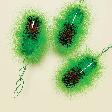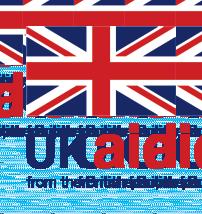




ThePacificOneHealth&AMRSymposium(POHAS2023)willbeheld atthePearlResort,PacificHarbour,Fiji.
rd th 23 & 24 August 2023
ThisSymposiumismadepossiblethroughthegeneralsupportofoursponsors:
Department of Foreign Affairs and Trade – Australia, Australian Centre for International Agricultural Research, World Health Organization, World Organisation for Animal Health, FoodandAgriculturalOrganisationoftheUnitedNations,UKAid,FlemingFund
MinistryofHealthandMedicalServices,MinistryofAgricultureandWaterways,Ministryof Fisheries and Forestry, Department of Foreign Affairs and Trade - Australia, Samoan Ministries of Health, Agriculture and Environment, Biosecurity Authority of Fiji, Consumer CouncilofFiji,FijiCollegeofGeneralPractitioners,FijiPharmaceuticalSociety,FijiNational University,TheUniversityoftheSouthPacific,ThePeterDohertyInstituteforInfectionand Immunity of the University of Melbourne, University of South Australia, University of Technology, Sydney, Pacific Community (SPC), Oceania Hospitals, Commonwealth ScientificandIndustrialResearchOrganisation,FijiMedicalAssociation,MinistryofForeign Affairs and Trade – New Zealand, University of Newcastle, Zens Medical Centre, Vet Essentials Animal Doctors, Goodman Fielder International, Aspen Medical, Future Farms Limited, Wildlife Conservation Society, Deakin University and Australasian College for Infection Prevention and Control, Fiji Meat Industry Board, Fiji Meteorological Service, ScientificResearchOrganisationofSamoa.
PROGRAMME
Registration
Welcome - NARC Chair
Keynote - Ministry of Health & Medical Services
Keynote - Ministry of Agriculture & Waterways
Keynote - Ministry of Fisheries & Forestry
945 - 10.05 am Research for One Health Systems Strengthening (ROHSS) and EMAR - Dr Anna Okello 10
-
am AMR Management in Samoa - Aiono Dr Alec Ekeroma
COMBAT-AMR Project Presentation - Professor Benjamin Howden
Group Photo and Morning Tea Break
PlenaryHall
GPR
One Health in the Pacific Community (SPC)
Eric Rafai
One Health Coordinator, Pacific Community
AMRS
Room 1 Room 2 Room 3
Facilitators
Session 11
Relooking at the delivering animal health care services in Fiji and the South Pacific region
Institute 11.50 - 1210 pm
Session 1 2
Prevalence of Antimicrobial Resistance Organisms, Knowledge on Antibiotic Use and Resistance
Among Poultry Farmers in Fiji
Razia Rashid Shivani
Fiji National University College of Agriculture, Fisheries and Forestry
Session 2.1
Assessment Of Knowledge, Attitudes And Readiness Of Healthcare Workers To Manage Pathogens With Critical Antimicrobial Resistance At Colonial War Memorial Hospital, Fiji
Aneley Getahun Strobel
Institute 1210 - 1230 pm
Peter Doherty Institute for Infection and Immunity
Session 3.1
Public Knowledge, Attitude, And Practice Towards Antibiotics And Antibiotic Resistance In Fiji
Fiji National University College of Agriculture, Fisheries and Forestry
Session 2.2
Dairy Production Dynamics and Antibiotics Sensitivity Patterns of Bacteria Isolated from Calf Diarrhea in Fiji
Session 1 3
Successful establishment of hybrid multidisciplinary bloodstream infection management group in Solomon Islands.
Alice Siuna
National Referral Hospital, Solomon Islands
Session 3.3
Tackling Human Health And Environmental Dimensions Amr Through Strengthening Capacity For Infection Prevention And Control, And Water, Sanitation And Hygiene
Ashlyn Datt
Fiji National University College of Agriculture, Fisheries and Forestry
Session 11.1
Governance for One-Health management of AMR in Fiji
Colonial War Memorial Hospital
Session 3.3
Towards a collaborative support framework to assist infection prevention and control programmes in low- and middle-income countries: a scoping review
Institute 1230 - 1.00 pm
Priya Chand
Fiji National University College of Medicine, Nursing and Health Sciences
Commonwealth Scientific and Industrial Research Organisation (CSIRO)
PlenaryHall
Block 1 Panel Discussions
School of Medicine and DentistryGold Coast, Griffith University
DAY 1: Wednesday, 23rd August 2023
1.00 - 200 pm
-2.20
Room 1
Session 4.1
Antimicrobial Consumption for Human and Veterinary Practices in Fiji
Room 2
Session 4.2
Managing diamondback moth resistance to insecticides in Fiji: a flexible strategy that minimizes use of hazardous chemicals.
Royford Magiri Fereti Atumurirava
Fiji National University College of Agriculture, Fisheries and Forestry
Session 51
Development Of Antimicrobial Use Guidelines For Animal Health In Fiji
Plant Health, Land Resources Division, Pacific Community
Session 5 2
Potential impact on one health from heavy reliance on chemical control of pests for plant health protection
Room 3
Session 4.3
Fiji Antimicrobial Resistance Surveillance Dashboard
Morgan Lewis
Commonwealth Scientific and Industrial Research Organisation (CSIRO)
Session 5 3
Case Study: Incorporating One Health into a Frontline Field Epidemiological Training Program in Papua New Guinea, Lessons Learnt
Speaker Institute 3.30 - 400 pm 400 - 410 pm
James Gilkerson
Mark Ero
University of Melbourne Pacific Community
Session 6.1
Prospective Observational Study Of De-Escalation Of Empirical Antibiotics In Patients Admitted To Colonial War Memorial Hospital, Fiji
Tracey Young- Sharma
Colonial War Memorial Hospital
Session 6.2
Building One Health Capacity And Relationships Is The Key To One Health
Sandra Steele
Tambri Housen
School of Medicine and Public Health, University of Newcastle
Session 6.3
One Health Approach For Monitoring
Amr: A Case Study In New Caledonia
Bourles Alexandre
Melbourne Veterinary School, The University of Melbourne Institut Pasteur de Nouvelle-Calédonie
Plenary Hall
Block 2 Panel Discussions
Wrap-up of Day 1
Launch of WISH Project Documentary 4.40 pm
410 - 440 pm
KEY:
A&C Awareness and Communication
Afternoon Tea
AMRS Antimicrobial Resistance Surveillance
IPC Infection Prevention and Control
AMS Antimicrobial Stewardship
GPR Governance Policy and Regulations
1
7.1
Exploring the resistome in sedimentassociated biofilms from rural Fijian watersheds: microbial ecology insights from the Watershed Interventions for Systems Health in Fiji Project (WISH -Fiji).
7.2
Council Spearheads Multi-Sectoral Panel Discussion on Antimicrobial Resistance (AMR)
Veterinary Foundations Of Infection Prevention And Control Course 2023
Facilitators
8.1
Development, Implementation And Evaluation Of An Antimicrobial Stewardship (AMS) Educational Training Platform For The Western Pacific Region
8.2
A One Health Epidemiological Survey Of Environmental Bacteria Using Whole Genome Sequencing
Rodney James Ethan Wyrsch
Australasian College of Infection Prevention and Control Ltd
8.3
Carbapenem-Resistant Organism Surveillance, Prevention, And Control In A Tertiary Hospital In Fiji
Aneley Getahun Strobel
The Doherty Institute University of Technology Sydney Peter Doherty Institute for Infection and Immunity
Session 9.1
Global Data Collection on Antimicrobial Agents intended for Use in Animals (AMU) and ANIMUSE – the New Online Platform
Session 9.2 Session 9.3
Strengthening Of Antimicrobial Resistance (AMR) Surveillance Through Laboratory Antibiograms
Genomic diversity of multi-drug resistant Gram-negative and Grampositive bacteria in Suva, Fiji
Nahoko Ieda Tebuka Toatu
Jane Hawkey
World Organisation for Animal Health The Pacific Community Department of Infectious Diseases Monash Central Clinical School
PlenaryHall
Block 3 Panel Discussions
Day 2 Group Photo | Morning Tea | Check Out AMS AMRS Room 1
Asheefa Aiyub, Royford Magiri
Session 101
Some Alternatives to Antibiotics in Livestock Production: A Review
2
102
Antimicrobial susceptibility of bacterial isolates from clinical specimens in four Pacific Island countries, 2017–2021
Lessons learned from bovine tuberculosis surveillance program in the Fiji Islands
The Alfred Hospital, Melbourne World Organisation for Animal Health
Session 3.2
Examining The Relationships Between Antrhopogenic Activities And The Resistome, Mobilome, And Virulome Of Waterbodies
Speaker Institute
1240 - 1.00 pm
1.00 - 200 pm
200 - 2.20 pm
Speaker
220 - 300 pm
Barbara Drigo
University of South Australia
Session 11.2 Session 11.3
Attributable mortality and excess length of stay associated with thirdgeneration cephalosporin-resistant Enterobacterales bloodstream infections: a prospective cohort study in Suva, Fiji
Michael Loftus
Multi-species carbapenem-resistant organism (CRO) case investigation at Colonial War Memorial (CWM) Hospital, Fiji
Tracey Young-Sharma
The Alfred Hospital, Melbourne Colonial War Memorial Hospital
PlenaryHall
Block 4 Panel Discussions
Lunch
PlenaryHall
Session 12 FAO and One Health in the Pacific
Raana Asgar and Kachen Wongsathapornchai
Session 13 Panel Discussions on Next Steps/Way Forward for NARC
NARC, WHO, WOAH, FAO, SPC, EMAR, COMBAT-AMR, DFAT
3.00 pm Closing of Symposium
KEY:
A&C Awareness and Communication
AMRS Antimicrobial Resistance Surveillance
IPC Infection Prevention and Control
AMS Antimicrobial Stewardship
GPR Governance Policy and Regulations
21-11-1976 - 06-07-2023
Ms. Numa Vera was originally from Papua New Guinea. She attained a Bachelor of Pharmacy degreefromtheUniversityofPapuaNewGuinea in2001.SheprogressedtodoaMastersinScience in Pharmaceutical Sciences at Gadjah Mada UniversityinIndonesiaandgraduatedin2008

The following year, 2009, she joined the former FijiSchoolofMedicineasaLecturerinPharmacy. In 2010, Fiji School of Medicine was combined into Fiji National University and Ms. Numa has remainedworkingintheuniversitytodate.While workingatFijiNationalUniversity,shecontinued to upgrade her education career In 2010, she graduated with Postgraduate Certificate in Public Health Research from Fiji National University. In 2013, she graduated from Monash University, Australia with Postgraduate Diploma in International Health then in 2014she attained a Postgraduate Certificate in Medical Education fromFijiNationalUniversity
Ms. Numa held a position as Assistant Professor in Pharmacy and is the Head of Department of Pharmacy&PharmacologyatFNUfrom2009up untilherpassing.
Her areas of research include Antimicrobial Resistance and Emergency Contraceptives. She is the lead person from FNU-CMNHS for the Enhancing the Management of Antimicrobial Resistance in Fiji (EMAR) project, focusing on humanhealth.
Ms Numa has contributed to research being donebytheEMARFijiprojectandwastopresent at this symposium however she unfortunately succumbed to cancer and passed away on the 6thofJuly2023
Restinpeace,Numa.













Antimicrobial resistance (AMR) is a human caused environmental challenge. Furthermore, the global stock of antibiotics, which is a non-renewable resource, is on the decline. In the Pacific region including Fiji, the occurrence of AMR, its causes, impact, and sustainable ways of managing it are poorly understood; sustainable management of complexproblemssuchasAMRisimportantincosteffective management of complex and disruptive threats, resulting in saving of scarce resources particularlyforlowincomecountriessuchasFiji.
TounderstandthemagnitudeoftheAMRproblem,a situational and needs assessment was first done in 2018 together with various stakeholders from the human,animalhealth,andtheenvironmentsectors to identify gaps in the management of AMR Afterwards, the Enhancing the Management of Antimicrobial Resistance (EMAR) project was codesigned, co-developed, and co-implemented together with all the National Antimicrobial ResistanceCommittee(NARC)memberssuchasthe Ministry of Health & Medical Services, Ministry of Agriculture,FijiNationalUniversity,andUniversityof South Pacific EMAR project is one of the projects under the Research for One Health System Strengthening(ROHSS)beingmanagedbyAustralia Centre for Agricultural Research (ACIAR) and DFAT's Indo-PacificCentreforHealthSecurity
Aimandfocalareas
The EMAR project is based on complexity science and interdisciplinary research and considers health systems (human, animal and environmental) as complex adaptive systems that are interconnected.
The aim of the project is to enhance the integrated management of antimicrobial resistance (AMR) through existing national structures, resulting in sustainability and improved health outcomes in Fiji. Theprojecthassixinterlinkedfocalareasnamely:
Ÿ · IntegratedAMRsurveillance
Ÿ · Laboratorycapacitybuilding
Ÿ · Economicsandriskanalysis
Ÿ · AMRgovernance
Ÿ · Antimicrobialstewardship
Ÿ · Policyandcommunityengagement
The EMAR project will increase knowledge on the occurrence of AMR in the Pacific region across the food, health, environment, water nexus. This will consequently lead to increased knowledge on how best to manage AMR in a cost-effective and sustainable manner The overall impact will be improvedwellbeingofpeopleandanimalsaswellas ecosystemresilience.Additionally,thePacificregion more broadly will be the ultimate beneficiary from the project success, due to lowered risk of AMR spreadunderaregionalpublicgoodsperspective.
Project partners include Commonwealth Scientific and Industrial Research Organisation (CSIRO), University of South Australia, University Technology Sydney, NARC members, FNU, USP, SPC, WHO, and FAO
TheprojectisfundedbyACIARandDFAT.
DrAnnaOkelloistheResearchProgramManagerforLivestockSystemsattheAustralianCentreforInternationalAgriculturalResearch,a specialistfoodsecurityagencywithintheAustraliangovernment'sforeignaidportfolio
A registered veterinarian, Anna holds a PhD in political science from the University of Edinburgh's Centre for African Studies. Since 2005 Anna has worked in international livestock development and publichealthprogramsinAfricaandAsia,withmanagementandresearchrolesinNon-Government Organizations,theUniversityofEdinburgh,UnitedNationsagenciesandtheAustraliangovernment
Anna has a strong interest in funding research for development projects that highlight the broader societalrolesoflivestock–includingsocialprotection,publichealthandgenderequity–inadditionto theirimportantroleinglobalfoodsystems. AnnaisarecognisedauthorityonOneHealthpolicyand governance;sheteachesonthissubjectattheUniversityofEdinburgh'sGlobalHealthAcademy,ison theBoardofCABIOneHealthandisaLancetOneHealthCommissioner
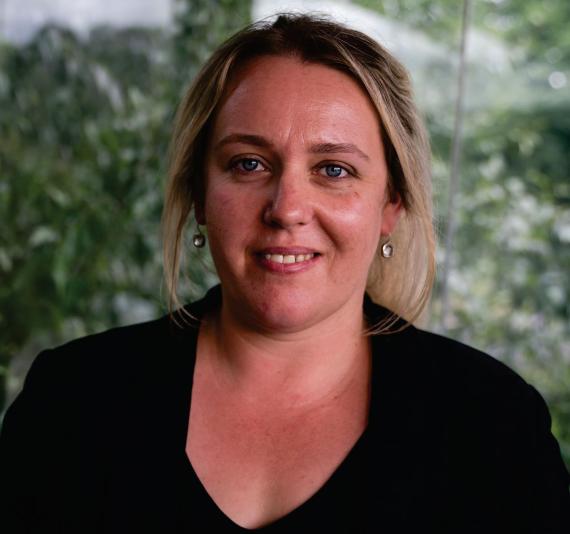
COMBAT-AMR works in partnership with government, National AMR Committees and public health counterparts in Fiji, Samoa, Solomon Islands and Papua New Guinea, to implement capacity building and training activities to support the prevention, diagnosis, surveillance, and management of AMR pathogens, under the framework of National AMR Action Plans and priorities. COMBAT-AMR is supported by the DepartmentofForeignAffairsandTrade'sIndo-PacificCentreforHealthSecurity
COMBAT-AMRdeliversaprogramofworkatmajornationalsites,includingreferralhospitalsandlaboratories, across four key themes: (1) infection prevention and control; (2) antimicrobial stewardship; (3) laboratory capacityandsurveillance;(4)animalhealth.
Under the infection prevention and control (IPC) theme, we have worked with the Colonial War Memorial Hospital (CWMH), Suva, Fiji, to support hand hygiene auditing, monitoring, and data collection, developed healthcare associated infection (HAIs) audit tools, reviewed and provided templates for standard operating procedures as well as participated in the Infection Control Committee (ICC) to provide technical support as needed.
In the antimicrobial steward (AMS) theme in Fiji, our project has provided training for 25 individuals representing Lautoka, Labasa and CWMH hospitals as well as Fiji Biomedical and Pharmaceutical Services (FPBS) with clinical and pharmacy background in antimicrobial auditing using the National Antimicrobial Prescribing Survey (NAPS). This survey provides the facilities an opportunity to observe prescribing trends withinthehospitalaswellascarryoutpointprevalencesurveyswithinthefacility Inaddition,wehaveworked withtheteamattheCWMhospitaltosupportimprovementmonitoring,feedbackanddatacollection.
The laboratory capacity and surveillance theme at CWM hospital, Suva, Fiji, has supported areas such as bacterialidentification,antimicrobialsusceptibilitytesting(AST),qualityassuranceandqualitymanagement, whole genome sequencing at the Microbiological Diagnostic Unit Public Health Laboratory (MDUPHL) in Melbourne, Australia, development of standard operating procedures, continuing remote support through online engagement and capacity building of four laboratory technician at the Doherty Institute, Australia in 2022
TheanimalhealththemehasworkedwiththeMinistryofAgricultureveterinariansandcollaboratedwithThe Pacific Community (SPC) to develop an antimicrobial treatment guideline which can be used by paraveterinariansandveterinariansinthefield.Thisguidelinehasreceivedendorsementfromtherespective ministry
Moreover,theCOMBAT-AMRprojecthascollaboratedwithotherpartnersinFijitosupportdevelopmentand improvement in clinical governance, PCR testing and surveillance capabilities through capacity building exercisesandactivitiesaddressingCarbapenemaseresistantorganisms.
SPEAKERPROFILE:ProfessorBenjaminHowden
Professor Benjamin Howden is Director of the Microbiological Diagnostic Unit Public Health Laboratory and Co-Director of the WHO Collaborating Centre for AMR at the Doherty Institute, Australia. He leads an extensive program of work across pathogen genomics, antimicrobial resistance, and clinical microbiology, across research, international capacity building and training, and policy. Professor Howden co-leads the Australian Government Department of Foreign Affairs and Trade funded COMBAT-AMR program.

Background
The Secretariat of the Pacific Community (SPC) now know as the Pacific community over the past decade recognised the importance of One Health approach to address priority issues and unique health challenges faced by Pacific island Countries and territories The SPC is an international development organisation governed by 27 members, including 22 Pacific island countries and territories around the Pacific Ocean. This abstract provides an overview of initiatives/ projects that weredevelopedwithinSPCanditspartnersthathaveevolvedintothecurrentfocusonOneHealth thatisaimedatintegratingandlinkingitskeydivisions.
Several information sources at SPC were used to collate historical events at SPC that allude to the adventofOneHeathtoitscurrentform.ThereisakeylistofprojectsbySPCthatinitiateOneHealth initiativesbythedifferentdivisionswithattemptsmadetoenablethe interactionofanimal,human andenvironmentinterfacewithimportantchallengesandlessonsforthenextlevelofdevelopment
Focus
Thefocusofthestudyistodescribetheearliestinitiativesandactivitiesof OneHealthinthePacific thathasshapedthedevelopmentofaOneHealthinitiativetoitscurrentstatus.
Scope
ThescopeofthestudydescribestheearliestinitiativeventureintoOneHealthinSPCas thePRIPP project that began 2003 and the different steps and influences that have evolved to the current strategic direction. The future direction is opportunistic with several global initiatives supporting a OneHealthapproachtoaddressingkeypriorityissuesforPacificislandsandequallyinterestedare partnersintheOneHealthAgendaintheregion.
Dr Eric Rafai is the former chair of the National AMR committee in Fiji (2015-2023) and currently employed at the Pacific Community as the One Health coordinator since May 2023.HewaspreviouslyemployedattheMinistryofHealth&MedicalservicesintheChief Epidemiologist role from 2018 and before that as the Deputy secretary for Public Health. He is a registered Public Health specialist with the Fiji Medical & Dental Council and has undertaken several leadership roles at regional and international level. Dr Rafai has postgraduatetraininginpublichealth(QUT),infectiousdisease(UWA)andmanagement (USP)andisarecipientoftheAustralianLeadershipAwards(2011).Hisfirstpublication as primary author was in 1997 and has since contributed to several publications in a wide rangeofinterestareas(Googlescholarprofile).

1CollegeofAgriculture,FisheriesandForestry,FijiNationalUniversity,POBox1544,Nausori,FijiIslands.
2CommonwealthScientificandIndustrialResearchOrganization
The interaction between animals, humans and the environment are a natural phenomenon that cannot be avoided. Consequently, the health of animals, humans and the environment are all interrelated as 'one health' The livestock sector is emerging as one of the fastest growing agricultural sub-sectors in Fiji and the expectations are that this growth could further accelerate duetogrowingincomesandthehigh-incomeelasticityofdemandforlivestockproducts.
Given the size and relatively equitable distribution of livestock in Fiji, this presents an excellent opportunityforthecountrytoboostruralincomesandacceleratethepaceofpovertyreduction.But successful capitalization of such opportunities requires a policy regime that facilitates growth in productivityatthefarmlevelaswellasintheprocessingsector Theproductivepotentialofanimals dependscruciallyonthequalityofnutrition,geneticmaterial,andtheanimalhealthsystem,andon allthesecounts,Fijihasapoorrecord.
Thepublicsectorcontinuestobetheprimaryproviderofveterinaryservices,andthedeteriorating fiscalsituationofmoststategovernmentsismakingitextremelydifficulttoeitherexpandthereach oftheseservicesorimprovethequality-of-servicedelivery.Although,onefficiencygrounds,thereis good rationale for commercialized delivery of these services, serious concerns prevail in Fiji about theequityimplicationsofprivatesectordeliveryorfullcostrecoverywithinthegovernmentsystem. Evaluation of the desirability of user fees or private delivery of livestock services requires an understanding of the factors influencing the demand for these services. Furthermore, veterinary publichealthshouldequallybealignedtothecoreveterinaryservices.Inthispaper,weexaminethe localdeliveryofanimalhealthcareservices,consideringthedifferentdeliverysystemsvis-à-visthe differentproductionsystems(humans,environment?).
Theroleofplannersandpolicymakersisexamined,toensurethattheyareadvocatingforchanges thatarecompatiblewiththeexistinganimalproductionsystemsandveterinarypublichealthandin linewithinternationalnorms.
MissRaziaRehanaRashidiscurrentlyaMasters(AnimalScience)studentatFijiNational University She has done Bachelor of Veterinary Science and Animal Husbandry at FNU and graduated in 2020 Miss Razia has worked as a Veterinary Clinician at Vet Essential AnimalDoctorsfor2.5years.SheleftworktopursueherstudiesafterbaggingtheACIAR Scholarship HerstudyfocusesontheSupplyandDemandofAnimalHealthCareServices inFiji.
SheisoriginallyfromNadiandnowlivingandthrivinginSuvafor9years.

FARMERS IN FIJI
Antimicrobial resistance is a current significant public health issue. However, in Pacific Island Countries such as Fiji, knowledge on the prevalence of antimicrobial resistance and its trend especiallyinlivestockisscarce.Todeterminethisacrosssectionalstudywascarriedout.Theresults showedthat98.2%oftherespondentwe'reraisingmorethanonetypeoflivestockincludingpoultry. The knowledge of antibiotics was low; only 31.1% of respondents knew what antibiotic drugs were and 68.9% had never heard about antibiotics. However, the source of this information was mainly fromtheMinistryofAgricultureofficersat267% Interestingly,88.9%didnotknowthemeaningof not using antibiotics correctly Disease treatment option was the top choice on why antibiotics are used in chicken at 18.2%. About 11.11% knew what the common problems were when antibiotic was not used correctly The general resistance pattern of the isolates to antibiotics was found to be as follows; ampicillin (35%), erythromycin (96%), tetracycline (35%), gentamicin (46%), meropenem (18%), norfloxacin (17%), kanamycin (16%), cefaclor (61%), and streptomycin (25%) To reduce antimicrobial usage and antibiotic resistance, it is required to increase awareness, create, and put intopracticesolutions
ShivaniSingh,hasaMastersofAnimalScience.AtFijiNationalUniversity she learnt how to connect veterinary science with animal production in contrast to Fiji's economy and agricultural practices. She was part of the CSIRO/ACIAR EMAR project as a student microbiologist for livestock production.MsSinghiscurrentlyworkingforACIARPASSCRastheirlocal coordinator

1NationalReferralHospital,SolomonIslands
2Pacific Region Infectious Disease Association
Background: Solomon Islands (SI) is a nation of 700,000 people with a small health workforce and no infectious disease physician. Bloodstream infections (BSIs) are a significant cause of mortality. Historically management of BSI in SI had been challenging, including delays in notification, lack of clinician understanding,non-standardisedapproachtopatientmanagementandlackofappropriateantibiotics.
Purpose:Amultidisciplinarygroupwithlocalandinternationalclinicianswasestablishedwiththepurposeof improving clinical management of patients with BSIs within a larger program to support training, and capacitybuildingtoaddressthethreatofantimicrobialresistance(COMBAT-AMR).
Methods/description of process, or experience: The Solomon Blood Stream Infection group includes physicians,surgeons,infectionpreventionand control(IPC)nurses,microbiologyscientistsand pharmacists at the National Referral Hospital with online support from international counterparts (PRIDA and Alfred Hospital). Weekly hybrid meetings provide real time review and patient management advice for positive blood cultures and multi-resistant organisms (MROs). There is a strong mentoring and information sharing focus. The meetings provide a forum to discuss issues relating to IPC, antimicrobial stewardship and microbiology
Results:WeeklymeetingshavebeenheldsinceMarch2022withdiscussionsondiagnosisandmanagement ofconditionssuchasinfectiveendocarditisandsurgicalsiteinfections.
Participantshave reported better dissemination of information and improved collaboration between teams. Thisresultedinthe earlyidentificationand containment oftwoMROoutbreaks,Audits,policiesand training have been developed and implemented from gaps identified during meetings. Local champions have reportedgainingknowledgeandconfidenceinBSImanagement
Conclusion:Thisprojecthighlightstheimportanceofmultidisciplinaryinvolvementandlocalengagementin the successful management of complex infections in low resource settings. It is expected that the same approachcouldbeeffectivelyappliedtothemanagementofnon-communicablediseases. The provision of regular online expert support is an effective and sustainable method to provide mentoring andsupportdevelopmentoflocalchampions.
Dr Alice Siuna graduated from the Fiji School of Medicine with an MBBS degree in 2007 ShehasalsodoneherPostgraduateDiplomainInternalMedicinein2014andaMastersin InternalMedicinein2017,bothfromtheFijiNationalUniversity
She is currently working at the National Referral Hospital, Solomon Islands, as a Consultant Physician for the past 5 years. She has a special interest in Infectious disease/AMS.DrAliceisalsothechairpersonfortheAMSandIPCattheNationalReferral HospitalsheworksatintheSolomonIslandsinthepastyearwithongoingmentoring.
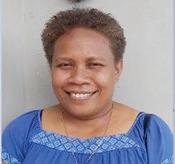
Introduction and objectives: Colonial War Memorial Hospital (CWMH) is the largest national referral hospital in Fiji. This survey was conducted to determine the knowledge, attitudes, and readiness of healthcare workers (HCWs) to manage outbreaks of pathogens with critical antimicrobial resistance (AMR) including laboratory detection, case management, and hospital infection prevention and control (IPC).
Methods: This cross-sectional survey was undertaken in July and August 2022 A structured self-administered questionnaire was developed which included: socio-demographics and professional information, and statements regardingknowledge,readinessandattitudetowhichsubjectsrespondedona5-pointscale(stronglydisagree,disagree, neutral,agree,stronglyagree).DatawereanalysedusingStatisticalPackageforSocialSciences.Thesurveyreceivedethics approvalfromCWMHandUniversityofMelbourne.
Results: A total of 395 HCWs completed the survey with the response rate of 96% Respondents comprised nurses (56%), doctors(30%)andlaboratorypersonnel(13%).Themajorityofrespondents(79%)werefemalesand66%betweentheageof 20and34years.
Overall,participantsreportedahighlevelofknowledge(86%-97%)aboutIPCmeasurestoreducethespreadofinfections. Themajority(>85%)knewthemodesoftransmissionofinfectionsinhealthcaresettings.Amonglaboratorypersonnel,65% thoughttheyhadadequateknowledgetodetectcriticalAMRorganisms.
Withregardstoreadiness,37%ofHCWsstatedthehospitalhadadequatecapacitytodetectcriticalAMRorganismswhile 32% stated it had adequate capacity to respond to a critical AMR outbreak Responses to resource availability for case managementweremixed;42%reportedresourceswereadequatewhile41%thoughtthehospitaldidnothaveadequate resources.
HCWs' attitudes were positive (84%) toward changing their work environment to prevent the spread of critical AMR infections.ThemajorityofHCWs(93%)agreedthatovercrowdinginthehospitalincreasedthespreadofinfection.
Conclusion: This survey revealed good knowledge of fundamental IPC measures and an emerging awareness of critical AMR among HCWs. Inadequate levels of readiness for critical AMR detection and outbreak response demonstrates the need for ongoing technical support and further resource allocation. The survey results have been used to guide comprehensivecapacitybuildingactivitiestoenhancelaboratorydetection,surveillance,andIPCinterventions.
SPEAKERPROFILE: DrAneleyGetahunStrobel
Aneley is a research project manager on antimicrobial Resistance at the Peter Doherty Institute for Infection and Immunity in Melbourne. She is an accomplished public health physician with a career spanning25yearsinAfrica,AsiaandthePacific

Aneley’s research interests are mainly in communicable diseases and antimicrobial resistance.Sheactivelyworkstoestablishcollaborativenetworks,fosteringpartnerships among organizations and experts in the realm of epidemiology and public health to improvepopulationhealth.
AneleyholdsaPhDformthePeterDohertyInstituteatUniversityofMelbourne,aMasters in clinical tropical medicine from the University of Mahidol in Thailand and a Medical DoctoratefromAddisAbabaUniversityinEthiopia.
Introduction: Livestock plays an integral role in many countries, especially in low and middle income.InFiji,thelivestocksectorisvitalandnecessaryinthesocio-economicdevelopmentof manyruralhouseholds. Rearingdairycattleforproducingdairymilkproductionisparamount as this is a source of dietary animal source protein for the general populace, generates regular incomeandfoodsecuritytomanyruralhouseholdsandotherbenefitsinthePacific Livestock inFijicontributes$48.3mtototalGDP.However,Fijiisstillinsufficientinitsmilkdemandsand has potential to export to many other Pacific Island countries. Antimicrobial resistance (AMR) can hinder the management of calf diarrhea in addition to being a significant threat to public health.Currently,theresistancepatternsoforganismcausingcalfdiarrheaisunknowninFiji.
Methods:TodeterminedatafromFijiAgriculturecensus2020,MinistryofAgriculture(MOA)as well as Fiji Corporate Dairy Company Limited (FCDCL). Also, this a cross sectional study was carriedouttodetermineantibioticssensitivitypatternsofbacteriaisolatesfromcalfdiarrhea.
Results: The results showed that more than 50% of all total Milking cows, dry cows, heifer, calf, bull, and steer is between the range of 1-10 followed by the range 11-20 then 21-50 animals per herdwithaverageofmilkproduced/day/cowof4.5L About66%(n=100)ofdairyfarmsproduce <4.5L of milk/day/cow. On the hand, 27% (n=41) of farms produce >= 4.5L of milk /day/cow. The studies on antibiotic sensitivity testing show that out of the nine antibiotic which is Ampicillin (AM), Penicillin (P), Oxacillin (OX), Doxyclycline (DO), Polymycin B (PB), Chloramphenicol, Cofactor, Streptomycin(S), and Ethromycin(E), bacteria isolated showed resistant to Oxacillin, streptomycin,Ethromycin.
Conclusion: This information is necessary to develop appropriate intervention strategies to increasemilkproductionandmitigatetheemergenceofantimicrobialresistanceinFiji.
Wati is a ACIAR (Australia Centre of International Agriculture Research) – Pacific scholar currently undergoing a Master's of Science in Agriculture focusing on livestock production under the EMAR project at the Fiji National University She is a Veterinary ScienceandAnimalHusbandrygraduatefromtheFijiNationalUniversity Watis'research is on the characterisation of dairy production dynamic in the Fijian dairy farms as well as prevalenceandantibioticssensitivitypatternsofbacteriaisolatedfromcalfdiarrheainFiji. Along with her current research she is also a recipient of the Future Thinkers' ACIAR Pacific Climate Change grant with aims to investigate the perceptions of the impact of climatechangeontheFijianDairyfarmersandfarm.

SESSION 2.3: TACKLING HUMAN HEALTH AND ENVIRONMENTAL DIMENSIONS AMR THROUGH STRENGTHENING CAPACITY FOR INFECTION PREVENTION AND CONTROL, ANDWATER,SANITATIONANDHYGIENE
Ilisapeci Nabose, Ashlyn Datt, Shammi Prasad, Bernadette Kennedy, Karishma Priti Nandan, DonnaCameron,AlisonMacintyreonbehalfoftheCOMBAT-AMRprogram
Purpose
COMBAT-AMR is an Australian Government funded program across four countries in the Pacific, designed to tackle antimicrobial resistance using a One Health approach. COMBAT-AMR has four operational arms: animal health; laboratory capacity; infection prevention and control (IPC) and water, sanitation and hygiene (WASH); and antimicrobial stewardship The program has been operatinginFijisince2020 ThiscasestudyfocussesspecificallyontheimplementationofjointIPC and WASH components at the Colonial War Memorial Hospital (CWMH). Adopting a joint IPC and WASH program was a novel approach to strengthen the prevention and control of AMR at the hospitalandminimisetheriskofspreadtosurroundingenvironments.
Focus
To jointly address WASH and IPC, a modified WHO Infection Prevention and Control Assessment Framework (IPCAF) was conducted jointly with the IPC team at CWMH. The modifications were made to more comprehensively include WASH across the IPC assessment A strengths-based reportwasdevelopedfromtheassessmenttoinformaprioritisedsetofactivitiestoimproveIPCand WASH with a focus on AMR. Capacity building has been the central approach to COMBAT-AMR's support to the CWMH IPC team. This has been executed through: regular mentoring sessions; incountry visits; workshops and on the job training sessions; development and update of standard operating procedures; and strengthening of audit processes and reporting. The partnership between CWMH and experts based in Australia has supported the sharing of procedures and expertisefromAustraliansettingsandthoseacrosstheregiontoinformabestpracticeapproachto a wide range of WASH and IPC areas such as environmental cleaning, surveillance, hand hygiene compliance,andWASH.
COMBAT-AMRhasresultedinstrengthenedcapacityacrossthehospitaltoimproveIPCandWASH, specificallytotackleAMRandtoimpactqualityofcaremorebroadly.
Funding
This work was funded by the Australian Government Department of Foreign Affairs and Trade's Indo-PacificCentreforHealthSecurityfundedCOMBAT-AMRProgram
SPEAKERPROFILE: MsAshlynDatt
AshlynDattisworkingatCWMHospitalwhichisoneofthelargesthospitalinFijiasanAct Team leader for IPC. She has been a nursefor 10 yearsand spent 5 yearsof her journey in IPC She has done bachelors of nursing and is currently doing Foundation in IPC to upgradeherknowledgeandskillsinIPC

1DepartmentofPharmacyandPharmacology,FijiNationalUniversity
2CSIROBlackMountainScienceandInnovationPark,CluniesRossStreet,ActonACT260,Australia
3CSIROData61,Hobart,Tasmania,Australia,7001
Introduction: AntibioticresistanceisathreatinFiji.Frequentoutbreakshavebeenreportedinthehospitals. NARC was established to address the issue. In the current NAP, NARC highlights the need to conduct more public awareness on antimicrobial resistance. Understanding the knowledge, attitude, and practices of the publictowardsantibioticsandantibioticresistanceisnecessarytopromoteawarenessinterventionsthatmay helpcontrolantibioticresistanceinthecountry
Methods:Thiswasadescriptivecross-sectionalstudyconductedinCentral,WesternandNortherndivisionsof FijifromSeptember2022toJanuary2023.Participantswhovolunteeredtotakepartwereinterviewedusing the structured questionnaire. The demographic characteristics of the participants were analysed using descriptive statistics using Microsoft Excel. IBM SPSS statistic version 27 was used conduct Chi square and binarylogisticalanalysis.
Results:Atotalof1220participantswithanaverageageof37±12yearsparticipatedinthestudy Overall,high levels of inadequate knowledge, negative attitude and inappropriate practice antibiotics and antibiotic resistanceweredocumented.Knowledgeisassociatedwithattitudeandnegativeattitudeisassociatedwith inappropriatepractice.Predictorsofknowledge,attitude,andpracticewereidentified.
Conclusion:Itcanbeconcludedfromthisstudythatoverall,thepublichaveinadequateknowledge,negative attitudeandinappropriatepracticetowardsantibioticsandantibioticresistanceinFiji.Continuousawareness programs on antibiotics and antibiotic resistance are recommended throughout the country A more targeted approach towards the predictors identified in this study may improve public knowledge, attitude, andpracticestowardsantibioticsandantibioticresistance.
Keywords:Antibioticresistance,antibiotics,knowledge,attitude,practice,Fiji
PriyaChandisanAssistantLecturerinPharmacywiththeDepartmentofPharmacy&Pharmacology,FijiNationalUniversity Sheholdsa BachelorofPharmacydegreefromSavitribaiPhulePuneUniversity,IndiaandattainedhersecondBachelorofPharmacydegreefromFiji NationalUniversity SheisalsoaregisteredpharmacistinFiji.

In this symposium she will provide an overview on 'Patient Knowledge, Attitude and Practice towards Antibiotics and Antibiotic Resistance in Fiji' This research was funded by the Australian Centre for International Agricultural Research through the Enhancing the Management of Antimicrobial Resistance project Researchers have found that the general public playsapivotalroleintheincreaseandspreadofantibioticresistance.Thepresentstudywasdesigned togetabetterunderstandingoftheexistingpiecesofevidencepertainingknowledge,attitudeand practicesaboutantibioticsinthegeneralpopulationinFiji.
Herpreviousresearchincludes“AnalyticalmethoddevelopmentforestimationofSerratiopeptidase usingQualitybyDesignapproach”whichwascarriedoutatSCES'sIndiracollegeofPharmacy,India. Another study entailed “Streptophotometric Analysis of Amoxycillin Capsules” that was part of her BachelorofPharmacyprograminFiji.Thiswasabaselinestudythatwouldprovideinformationbase againstwhichtomonitorandassessvalidationprocedureforAmoxycillinTrihydratecapsules.Thirdly, as part of the pharmacy internship program she completed a research study entitled 'Patient KnowledgeandPerceptionaboutAntibioticsinCommunityPharmacy'
a b b b Barbara Drigo , Steven P. Djordjevic , Ethan R. Wyrsch , Max C. Cummins , Walter O.
c c d e f a Okelo ,KeithHayes ,RoyfordMagiri ,VincentLal ,NumaVera,EricaDonner
aFutureIndustriesInstitute,UniSASTEM,UniversityofSouthAustralia,MawsonLakes,SA,5095,Australia
bAustralian Centre for Genomic Epidemiological Microbiology, University of Technology Sydney, PO Box 123, Broadway, NSW 2007, Australia
cThe Commonwealth Scientific and Industrial Research Organization (CSRIO), Land and Water, Black Mountain, Canberra, ACT 2601, Australia
dDepartmentofVeterinaryScience,FijiNationalUniversity,Koronivia,Nausori,FijiIslands
eTheInstituteofAppliedSciences,TheUniversityoftheSouthPacific,LaucalaCampus,Suva,FijiIslands
fDepartmentofPharmacyandPharmacology,FijiNationalUniversity,Suva,FijiIslands
Introduction and objectives: As a One Health issue impacting life across humans, animals, and the environment, antibiotic resistance is found in one of the most basic resources for life – water. Antibioticresistant pathogens and their genes have been found in (waste)waters, streams, rivers, lakes, and oceans. Here, we used a comprehensive integrated analysis encompassing isolation of carbapenem-resistant bacteria, whole genome, and shotgun metagenomics to track the fate of the resistome, mobilome, and virulome in surface waters and (waste)waters from several waterbodies and wastewater treatment plants in Suvaandsurroundingperi-urban,agricultural,andpristineareas.
Methods:Toprovidegloballycomparativedatasetsandtolinkthisstudydirectlytolocalepidemiologicaldata, qPCR assays were designed to mirror molecular assays currently used for international-wide human surveillancefornosocomialandcommunity-acquiredantimicrobial-resistantinfections.
Results: The class 1 integron-integrase gene (intl1), a proxy for multi-drug resistance, sulfonamide (sul1) and extended-spectrum -lactam (blactxm32, blaSHV, blaTEM, blaGES, blaKPC) genes increased sharply in (waste)water, peri-urban and urban waterbodies. Whereas tetracyclines (tetW), vancomycin (vanA), and quaternary ammonium compounds (qacE) were significantly abundant in agricultural catchments Interestingly, polymyxin resistance genes (mcr1-5) were abundant in pristine waterbodies. (Waste)waters, agricultural, peri-urban, and urban waterbodies were carriers of multidrug-resistant and virulent ESKAPE pathogens,includingE coliST131andSt69
Conclusion: andsurroundingperi-urban, Thiscomprehensivestudyof(waste)watersandwaterbodiesinSuva agricultural,andpristineareasprovidesnewinsightintodriversofantimicrobialresistanceandpinpointskey monitoringtargetsindicativeofwherehumansourcesandexposuresarelikelytobemostacuteandinneed ofmulti-sectorsurveillance.
Dr Barbara Drigo conducted her doctoral studies at the Netherlands Institute of Ecology and was awarded her PhD in 2009 from the University of Leiden (Netherlands). Her PhD research involved utilizingseveralinterrelatedmethodsinmolecularmicrobialecology Subsequently,sheservedasa research fellow at Wageningen University (Netherlands), where her focus was on studying the correlation between disease suppression and bio-control agents. Shortly after, she relocated to the Hawkesbury Institute for the Environment (Australia), where she developed novel experimental systemstoinvestigatemicrobialdynamicsandfunctioninginresponsetoenvironmentalchanges.In August 2016, Dr Drigo joined the University of South Australia, where she currently leads a research group with a strong emphasis on applied research that significantly contributes to microbiological practicesinhuman,animal,andenvironmentalhealth.DuringhertenureatUniSA,Dr.Drigoplayeda pivotal role in securing and managing total research funding amounting to $6M. Moreover, her contributions have been crucial in laying the groundwork for the Cooperative Research Centre for SolvingAntimicrobialResistanceinAgribusiness,Food,andEnvironments(CRCSAAFE;$149M).

RunningTitle:InfectionPreventionandControlCollaboration
1
2,3,4*
2,5
FestusAdams,Peta-AnneZimmerman ,VanessaLSparke MattMason
2,6
1. CentreforEnvironmentandPopulationHealth,SchoolofMedicine,GriffithUniversity,GoldCoast,Queensland,Australia
2 CollaborativefortheAdvancementofInfectionPreventionandControl,Queensland,Australia
3. MenziesHealthInstituteQueensland,GriffithUniversity,GoldCoast,Queensland,Australia
4 DepartmentofInfectionControl,GoldCoastHealth,GoldCoast,Queensland,Australia

5. CollegeofHealthcareSciences,JamesCookUniversity,Cairns,Queensland,Australia
6 UniversityoftheSunshineCoast,SippyDowns,Queensland,Australia
Background: Infection prevention and control (IPC) in low and middle income countries (LMIC) is often constrainedbylimitedresourcesandcompetinghealthpriorities,necessitatingexternalagencysupport Yet, noreportedframeworksexisttoguidethedevelopmentofsuchcollaborations.
Aim:ThisstudyaimedtoidentifythecoreelementsofacollaborativesupportframeworktostrengthenIPCin LMICs.
Methods:Asystematicscopingreviewofliterature(2005-2020,inEnglish)wasconductedbasedonPRISMA 2020guidelines.MEDLINE,CINAHL,Embase,andScopusdatabaseswereutilised,withasearchstrategythat includedvariedcombinationsofMeSHterms,EmtreeandIPC-relatedkeywords.
Results: Six core elements of a comprehensive IPC collaborative support framework were identified: 1) Collaborative Projects, 2) Policies and Procedures, 3) Training and Professional Development, 4) Surveillance Systems, 5) Assessment and Feedback, and 6) Partnerships, the latter being a crucial enabling factor The analysis showed that training and collaborative projects benefit from pre-workshop preparations and multidisciplinarygroups,fosteringcollaborationandskillsenhancement Workinggroupsofmultidisciplinary stakeholdersprovedpivotalinIPCcollaborations,providingforumsforinformationexchangeandassistingin resource development. Their input fortifies partnerships, underscoring the interconnectedness of the elements.
Conclusion:Theidentifiedcoreelementsshouldguidetheconstructionofacollaborativesupportmodelfor IPCinLMIC ThenextstepisdevelopingaframeworkofequitablyempoweredpartnershipsforsustainedIPC improvementinLMICsettings.
Keywords:infectioncontrol,healthcaresystems,collaboration,lowandmiddleincomecountries.
SPEAKERPROFILE:DrPeta-AnneZimmerman
Dr Peta-Anne Zimmerman is an internationally respected clinician, educator and researcher in infection prevention and control.DrZimmerman'sexperienceincludesconsultancyworkwiththeWorldHealthOrganization(WHO),AusAID,the AsianDevelopmentBank(ADB),theSecretariatofthePacificCommunities(SPC),TheAlbionCentreandasamemberof the WHO SARS Response Team. Her expertise has led her to work extensively in China, South East Asia and the South Pacific, directly on outbreak response, and the development of comprehensive infection prevention and control programmes and integration of public health and acute care response in infectious disease emergencies in low and middle income country settings. Peta-Anne is a Board DirectoroftheAustralasianCollegeforInfectionPreventionandControl(ACIPC),Chairof the ACIPC Research, Grants, and Scholarship Committee, ACIPC representative and facultyfortheGlobalOutbreakAlertandResponseNetwork(GOARN),andmemberofthe ACIPC Credentialling and Professional Practices (CAPS) Committee. Peta-Anne directs the Graduate Infection Prevention and Control Program at Griffith University and is a Visiting Research Fellow with the Gold Coast Hospital and Health Service, Australia. Her researchfocusisinfectionpreventionandcontrolandoutbreakresponse,includingnovel approaches to the teaching and learning of this discipline, and health education in general,includingtheuseofpop-cultureandzombies.
1 2 3
RoyfordMagiri,ChamindaDissanayake ,WalterOkello1CollegeofAgriculture,FisheriesandForestry,FijiNationalUniversity,POBox1544,Nausori,FijiIslands.
2BiosecurityAuthorityofFiji(BAF),Level3,ProvidentPlazaI,ElleryStreet,Suva,Fiji
3Commonwealth Scientific and Industrial Research Organization, Black Mountain Science and Innovation Park, Clunies Ross Street, ActonACT260,Australia
Abstract
Introduction:Globally,thedemandforanimalproteinforhumanconsumptionhasbeenincreasingatafasterrateinthe last 5 to 10 decades resulting in increased antimicrobial consumption in food producing animals. Antimicrobials are frequentlyusedaspartofmodernmethodsofanimalproduction,whichmayputmorepressureonevolutionofantibiotic resistant bacteria. Despite the serious negative effects on animal and human health that could result from using antibiotics,therearenoassessmentofantimicrobialsconsumedbythelivestocksectorinFijiaswellasotherPacificIsland Countries.
Methods: The objective of this study was to quantify antimicrobials imported for consumption in food animals into Fiji from 2017 to 2021 and antibiotics sale at the retail pharmacies. Data on imported antimicrobials, which were finished products,wasobtainedfromBiosecurityAuthorityFiji(BAF).Additionally,Atotalof83pharmacistswereinterviewedinFiji in2022usingastandardquestionnaire.Datarecordedincludeddemographicvariables,typesofantibioticssold,antibiotic customers,antibioticprescribingpracticesandknowledgeofantibioticuseandAMR.Importedantimicrobialswerethen analyzedbyantimicrobialclass,andimportancetoveterinaryandhumanmedicine.Similarly,thequestionnairedatawas analyzedforthesaledynamics.
Results: 9286kgperyear(sd=6412)ofantimicrobialsasanetweightwasimportedintoFijiinthe2017-2021 Anaverageof studyperiod.Themeanamountofimportedactiveantimicrobialingredientsafteradjustingforanimalbiomasswas086 mg/kg(sd=0.59).Fromthetotalantimicrobialimportsduringtheyears2017to2021,penicillin's(69.72%)andtetracycline (15.95%) were the most imported antimicrobial classes. For animal health 9648% of the antimicrobial imports were veterinary critically important antimicrobials. For human health fluroquinolones, macrolides, aminoglycosides, and penicillin's were the imported critically important antimicrobials. Our study also shows that at the retail level, there is a considerableoverlapbetweenantibioticclassessoldforbothhumanandveterinarymedicine.Penicillin's,metronidazole, fluoroquinolones, and first and second-generation cephalosporins were reported as being amongst the four most sold antibiotic classes by the human drug stores. Whilst in our study, clinical training significantly influenced knowledge on issuesrelatedtoantibioticuseandAMRandrespondentshadarelativelyadequatelevelofknowledgeaboutAMR,several inappropriateprescribingpracticeswereidentified.
Conclusion: The study concluded that use of antimicrobials in food producing animals is low but monitoring of antimicrobial consumption and antimicrobial resistance was critical in Fiji due to overreliance on critically important antimicrobialsandoverlapbetweenantibioticclassessoldforbothhumanandveterinarymedicine.
Keywords:antimicrobialresistance,antimicrobialconsumption,Fiji,
Dr Royford Magiri is anAssistantProfessor ofVeterinary Microbiology in the Department ofVeterinary Science,School of AnimalandVeterinarySciencesattheCollegeofAgriculture,FisheriesandForestry,FijiNationalUniversity
He studied his PhD in Vaccinology and Immunotherapeutics at the School of Public health, University of Saskatchewan, Canada. His other qualifications are MSc. In Clinical Studies and Bachelor of Veterinary Medicine both from the University of Nairobi, Kenya. He has been involved in tertiary teaching for the last 10 years in areas of Veterinary surgery, Veterinary internal Medicine, Reproduction and obstetrics, Immunology, Microbiology and Virology, Immunotherapeutics, adjuvants and antibiotics, Vaccine, vaccination and infectious diseases, Animal welfare and ethics working first in Kenya, Canada and Fiji.


2 School Of Biological Sciences, The University Of Queensland, St Lucia, 4072 Queensland, Australia.
In Fiji, management of the diamondback moth (DBM), Plutella xylostella L (Lepidoptera: Plutellidae),hasbeenconstrainedbyresistancetobroad-spectruminsecticidesandlackofreliable access to selective products. Since 2013, the susceptibility of DBM field populations to a range of insecticides has been monitored and new selective products have been sequentially introduced and incorporated into an insecticide resistance management (IRM) strategy The strategy is based onthe“window”principlepromotedbytheInsecticideResistanceActionCommittee(IRAC).Itrelies onthelimiteduseofinsecticideswithdifferentmodesofactionindiscretetemporalwindowsthat equatetothedurationofthelifecycleofthepest( tominimizeexposureofsuccessive ≈18daysinFiji) generationstosimilarlyactinginsecticides.Constrainedbytheinsecticidesavailabletofarmers,the original strategy, developed in 2014, included indoxacarb, lufenuron, abamectin, AgChem-Bt (aizawai) and chlorantraniliprole. The strategy, which was initially supported by community meetingstoengagefarmers,workedwellthroughto2017andthesusceptibilityoffieldpopulations to the recommended insecticides remained high. In 2018 high levels of DBM field resistance to indoxacarb, chlorantraniliprole and deltamethrin were detected, indicating that the IRM strategy was either no longer effective or not being adopted. Efforts to increase the range of selective insecticides available were increased and AgChem Bt (kurstaki) and spinosad were introduced to the market in collaboration with a local pesticide reseller. The IRM strategy was revised to include these additions and it was promoted in farming communities by information sessions. Between 2019and2022resistanceofDBMfieldpopulationstotheoriginalrecommendedselectiveproducts declined and susceptibility to spinosad and both AgChem Bt products remined high. The importance of continued community engagement for successful IRM and IPM adoption and sustainableinsecticideusethatminimizeshazardouschemicalswillbediscussed.
SPEAKERPROFILE: MrFeretiAtumurirava
Fereti Atumurirava, an applied entomologist, specialises in integrated pest management, judicious use of pesticides in crop production, Brassica pest resistance monitoring on pesticides and its management. Strong advocate of human and environmental health protection. Representing Plant Health, Land Resources Division (LRD), Pacific Community(SPC).
Morgan Lewis, Lauren Stevens , Keith R Hayes , Adrien Ickowicz , David Peel , Walter Okelo , 5 andNumaVera
1CSIRO IMT, Kensington, Western Australia, 6151
2CSIRO IMT, Clayton, Victoria, 3168
3CSIRO Data 61, Hobart, Tasmania, 7001
4CSIRO Environment, Canberra, ACT, 2601
5Department of Pharmacy and Pharmacology, Fiji National University
Introductionandobjectives
'Enhancing the Management of Antimicrobial Resistance' is a project in which the Commonwealth Scientific and Industrial Research Organization (CSIRO) partnered with the Fiji Government to enhance the management of antimicrobial resistance (AMR). For the project, the Scientific Computing team at CSIRO developed a prototype dashboard for AMR surveillance. The dashboard visualised eight years of AMR data collected from the Colonial War Memorial hospital, Fiji's largest hospital. The aim was to provide visualisations that would aid in monitoring AMR.
The dashboard tracks the resistance of pathogen-antibiotic pairs, shown at different levels of detail. The focus of the design process was to allow for easy identification of pathogens with high AMR, whilst providing enough information for each pair to show trends across time and patient demographics. The dashboard was developed using the Shiny web framework.
The dashboard consists of three key elements: (1) A main table showing antimicrobial resistance for every pathogen-antibiotic pair; (2) a series of filters for the sample dataset to filter by year and sample type; and (3) a sideboard that showed the resistance for a specific pair in more detail, over time and by patient demographic. The dashboard is in use by the National AMR Committee with plans for periodic updates as patient data continues to be collected.
Morgan Lewis (BSc (Hons), MPE) is a Scientific Computing Specialist in the Data Analytics and Visualisation Team in CSIRO's Scientific Computing Group The Group designs and creates novel analytics and visualisationtoolstobringdatainsightstoscientistsinadiverserangeof fields. Since joining CSIRO in 2021, Morgan has collaborated with research groups across topics including AMR, climate science, and AI surrogatemodelling.

1,4
Antimicrobial resistance is best combatted by development and implementation of good antimicrobialstewardship.Amajorcomponentofanyantimicrobialstewardshipprogrammeis the availability and use of guidelines for prescription and dispensing of antimicrobial drugs. Unfortunately, appropriate animal health guidelines are not available for in many countries, severely limiting implementation of good antimicrobial stewardship The COMBAT-AMR AnimalHealthteam,incloseconsultationwiththeMinistryofAgriculture,hasdevelopeddraft Fijian Antimicrobial Prescribing Guidelines. These guidelines provide advice on when to use antimicrobials to treat animals, which antimicrobials are most appropriate to use for bacterial diseases commonly seen in Fiji in cattle, sheep, goats, poultry, pigs and horses, as well as guidanceonbestpracticedoserates.Theyalsoprovideguidanceaboutthedoseratesfordrugs used for chemical restraint and pain relief in each species, the method to use to estimate the body weight of each species to assist in calculating doses, and symptomatic treatments for each disease, where appropriate. In addition, the guidelines include information about vaccination schedules, anthelminthic dose rates and normal clinical parameters for each species.Onceapproved,theguidelineswillbeprintedonwaterresistantcard,toensuretheyare suitable for use by veterinarians and para-veterinarians in the field, to support Fiji's efforts to combatthegrowinginternationalproblemofantimicrobialresistance
ThisworkwasfundedbytheAustralianGovernmentDepartmentofForeignAffairsandTrade's Indo-PacificCentreforHealthSecurityfundedCOMBAT-AMRProgram.
James is a Professor of Veterinary Microbiology at the Melbourne Veterinary School. He is a veterinarygraduatefromtheUniversityofSydneywithaPhDinVirology. James’researchinterestsareprimarilyintheepidemiologyandcontrolof infectious diseases in animal populations, and this is how he became involvedinresearchintoantimicrobialstewardshipandantimicrobialuse in animals. James is committed to improving veterinary diagnostic microbiology capacity and using the data generated as a basis for responsible antimicrobial use in animals James is a Fellow of the Australian Veterinary Association and currently serves as a Director of AVA

SESSION 5.2: POTENTIAL IMPACT ON ONE HEALTH FROM HEAVY RELIANCE ON CHEMICAL CONTROL OF PESTS FOR PLANT HEALTH PROTECTION
Ero,M,Atumurirava,AandSusumu,GSustainableAgricultureProgramme,LandResourcesDivision,PacificCommunity(SPC),Suva,Fiji
Holistically, plant health is an integral component of one health. All forms of life on earth including the fauna and flora biota are intrinsically connected through the food web and are ecologically interdependent for survival. When one component of the web is disturbed, the impact transcends through other elements of the web that are dependent on it with subsequent flow on effect throughouttheweb
Allfloraincludingfoodplantsandphytoplanktonsinaquaticecosystemsprovidesourceoffoodfor herbivorousfeedersthatincludehumansandmicro-organismsatthelowertrophiclevel.Cultivated food crops form the key source of food for humans and livestock. Because of the high demand for foodcompelledbytheever-increasingglobalhumanpopulation,naturallandscapesareclearedfor monocultural cultivation of crops. When large natural land areas are cleared, and single crops are cultivated on large scale, they provide conducive environments for organisms from the disturbed environmentstoestablishaspestsandattackthecrops.
Asquickfixtothe pestissues,plantprotectionistsand farmersrelyheavilyonpesticidestoprotect the health of their crops. Unfortunately, heavy reliance on chemical control options imposes negative impacts on humans, biodiversity and the environment Effective ways of managing pesticidesthatcircumventsthenegativeimpactsisurgentlyneeded.Thispresentationoutlinesthe negative impacts of pesticides and argue the case for effective control of pests with limited use of chemicals, using the Coconut Rhinoceros Beetle management system as an example for effective pestmanagementwithminimalconsequencesononehealth.
Mark Ero is an Entomologist based with the Land Resources Division of the Pacific Community (SPC) managing the regional Coconut Rhinoceros Beetle project He has a PhD in Insect Ecology from the Queensland University of Technology (QUT) and Post Graduate Diploma in Entomology from the University of Queensland (UQ). He is a PNG nationalandworkedforseverallocalorganizationsbeforejoiningSPC
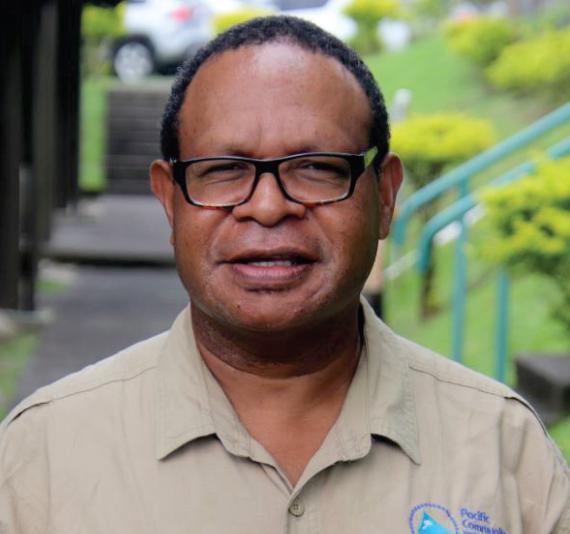
1,2 2,3
2,4 6 Malio,K .,Peni,B .,Hevoho,E .,Yamba,A .,Pukienei,A .,Macfarlane-Berry,L .,Velasco 6 2 6 6 Ortuzar,T .,Ropa,B .,Housen,T .,Kearns,T .
2NationalDepartmentofHealthFieldEpidemiologyTrainingProgram,PapuaNewGuinea
3WestNewBritainProvincialHealthAuthority
Purpose:Giventheincreasingthreatofcurrentandemergingdiseasesandotherhazardseventsaffectingthe complexinteractionbetweenhuman,animalandecosystemhealth,acoordinatedandinterdisciplinaryOne Healthapproachtoprevention,detectionandcontrolusingaOneHealthapproachwasidentifiedasapriority forPapuaNewGuinea(PNG).InPNG,OneHealthapproachesarebeingusedforantimicrobialresistanceand to establish surveillance strategies for zoonotic disease however, there is no training program that incorporatesOneHealthandfieldepidemiologyamongfrontlineworkerswhoareideallysituatedtoidentify eventsofconcern.
Methods: A co-creation approach was adopted during the development of a One Health field epidemiology curricula for frontline workers from human, plant, animal, conservation, and fisheries sectors. The training program was tailored to the PNG context, addressing both sector-specific and cross-sectoral requirements. The development process included a needs assessment, curriculum development, training of trainers, and clear participant selection criteria. The curricula were piloted and adapted in four provinces of Papua New Guinea.
Focus: The f-FETPNG program was created to address the real-world challenges being faced in PNG The training integrates One Health principles, community engagement, and field epidemiology techniques to equip participants with the knowledge and skills necessary for detecting, responding to, and preventing eventsofconcern.Asecondaryaimwastobuildstrongercommunicationacrosssectorsattheprovinciallevel.
Scope: The One Health f-FETP program was developed through a collaborative effort between the National DepartmentofHealth,NationalAgricultureQuarantineandInspectionAuthority,internationalpartners,and otherlocalstakeholders;designedtoaddressthecountry'sspecifichealthandhazardouseventsofconcern. Theprogramsuccessfullyimprovedthecapacityoffrontlinehealthworkerstoidentify,reportandparticipate in response efforts to prevent and control events of concern. The curriculum is likely to be relevant to other islandnationswithsimilarcontextandchallengesasPNG.
Assoc Prof Housen is affiliated with the Australian National University and the University of Newcastle. She has worked in the areas of complex humanitarian emergencies, primary health care service delivery, mixedmethods operational research, and health security workforce strengthening.InhercurrentroleasPapuaNewGuineaprogramleadfor Field Epidemiology in Action she works closely with the National Department of Health on establishing provincial rapid response teams and building field epidemiology capability through the national field epidemiologytrainingprogram(FETPNG).

Introduction:AntimicrobialresistanceisaglobalhealththreatandFijiisnotexempt Appropriateprescribing andtimelyde-escalationofantibioticsisanintegralcomponenttoanyantimicrobialstewardshipprogram.
The purpose of this study was to undertake a prospective observational study of de-escalation of empirical antibiotics in patients admitted with suspected infection admitted in the acute medical and intensive care wardsAdditionally,thepurposewastoreportonthede-escalationoftheseempiricalantibioticsinrelationto theavailabilityof(exampletheidentityoftheorganismanditssusceptibilitypattern).
Aim:Theaimofthestudywastoassesswhetherempiricalantibioticsarebeingadjustedinatimelyfashionin patients admitted with a diagnosis of suspected infection to the Acute Medical and Intensive Care Unit in CWMHoverthreemonths,fromFebruarytoApril2019,inresponsetomicrobiologicaldiagnosticinformation oftheinfection.
Objectives: Describe the demographics of patients admitted with suspected infection receiving empirical antibiotics admitted in AMW and ICU at CWMH and describe and evaluate their antibiotic regimen and duration,aswellascultureresultsandthetimingofde-escalationofantibiotics,fromtheperiodFebruaryto April2019
Methods:Aprospectiveobservationalstudywasundertaken.
Results: There were 474 patients prospectively enrolled. Almost all (99%) of the ICU and 75% of the AMW admissionsweresuspectedtohaveaninfectionandprescribedantibiotics.Ofthese350(74%)ofpatientshad afinaldiagnosisofinfection,principally,'infectionwithoutaspecificfocus'(41%)andrespiratorytractinfection (37%).Bloodcultureswerepositivewithsignificantpathogensin59outof424(13.9%).Staphylococcusaureus was the most common cause of bacteraemia in 17(40%). There were 39 Gram negative isolates that were considered significant in blood culture of which 9 (23.14%) were ESBLs. Only 137 (29%) patients had their antimicrobialregimende-escalatedinthefirst72hourspost-admissionbasedontheirmicrobiologicalresults whereas,207(42%)werede-escalatedmorethan72hoursafteradmission(OR=0.5,95%CI03–089;p<0016).
Conclusion: At CWMH admissions for infection and multidrug resistant organisms are common. Deescalation is slower than standard practice and may be improved by quicker laboratory results generation, bettersystemsfortreatingteamstoreviewresultsandagreaterrangeofnarrow-spectrumantibioticstoallow de-escalation.
Tracey Young Sharma is a Consultant General Medicine Physician at ColonialWarMemorialHospital(CWMH),Fiji.Herinterestisininfectious diseases, microbiology and research in antimicrobial resistance. She is currentlytheInfectionPreventionControlCommitteeChairandinvolved in antimicrobialstewardshipactivitiesinCWMH.

MelbourneVeterinarySchool,TheUniversityofMelbourne
Local,nationalandglobalstrategiestomanagetheincreasingriseofantimicrobialresistance(AMR) require a coordinated plan of action across multiple sectors and disciplines. Using a One Health approach is crucial to implement interventions for problems at the intersection of human, animal andenvironmentalhealth.However,integratedapproachestocomplexproblemssuchasAMRare constrained by the siloed structures of existing discipline-based health systems. Within our research, teaching and practice of One Health in Australia and the Asia Pacific we have observed a common need to build shared knowledge and understanding of One Health amongst frontline workers,practitioners,decision-makersandstakeholderstooptimiselong-termoutcomes.
Buildingcross-disciplinaryandcross-sectoralrelationshipsisfoundationaltodevelopknowledgeof skills and expertise of all actors in the One Health space, enabling effective collaboration and communication.Thisallowsidentificationofbothcommongoalsandindividualsectoralneeds,and theabilitytoaddresstheseinaholisticway.Thisgrowthinunderstandingprovidesbenefitsforeach sector,furtherincentivisingengagementandcooperationacrossdisciplinaryboundaries.
Additionally, strengthening One Health capacity requires education at all levels- from frontline workers to those in governance. Interventions should be designed and implemented using a consultative process, engaging country partners, stakeholders and the community alongside teachers and experts to develop content contextualised to local needs. Use of different modalities, includingonline
andfacetofaceresources,canimproveaccessibilityoftraininganddiversityoftrainees.
Development of a strong One Health workforce is imperative in the face of continuing threats to globalhealthandwellbeing,providingasustainableframeworktomanageAMRandotherexisting andemergingproblems.
SPEAKERPROFILE: DrSandraSteele
SandraSteeleisalecturerinVeterinaryEpidemiologyandOneHealthat the Melbourne Veterinary School, University of Melbourne After graduating from Veterinary Science at The University of Sydney, she worked in clinical practice, completed a Master of Public Health in 2014, and then a PhD on operationalisation of One Health to progress preparedness and response to emerging infectious diseases and zoonoses.Herresearchinterestsincludebuildinghealthsystemcapacity by facilitating One Health practice at all levels - from frontline health workerstogovernance.

a.Institut Pasteur de Nouvelle-Calédonie, Pôle de Bactériologie, Groupe de Bactériologie Médicale et Environnementale, CEDEX BP 61, Noumea 98845, New Caledonia
bBacterial Symbionts Evolution, Centre Armand-Frappier Sante Biotechnologie, Institut National de la Recherche Scientifique, Universite du Quebec, Laval, Canada
cThe Pacific Community, Public Health Division, Noumea, New Caledonia
d.Centre Hospitalier Territorial Gaston-Bourret, Laboratoire de Biologie Médicale, CEDEX BP J5, Noumea 98849, New Caledonia
The rapid emergence and spread of (multi)resistant and pathogenic bacteria is a priority health issue. Despite their insularity, the Pacific Island Countries and Territories have not been spared by this pandemic. In New Caledonia, the surveillance of antimicrobial resistance traits was historically investigated through clinical studies, based on large numbers of samples from individual patients toprovideepidemiologicaldata.
Overthepastdecade,wastewatersurveillancehasbeenincreasinglyusedtoreflectthepopulation's gut microbiota, raising the possibility of using wastewater-based epidemiology to directly gain information about antimicrobial resistance In this context, carbapenemase-producing Enterobacteriaceae, classified as priority pathogens by the WHO and implicated in hospital outbreak in New Caledonia have been isolated from clinical and wastewater sample. Given the diversity of resistant bacteria in wastewater, carbapenemase-producing Enterobacteriaceae were isolated using an easy-to-apply phenotypic method developed in our lab Several isolates were whole genome sequenced to identify the repertoire of lineages, genes and mobile genetic elementsinvolvedincarbapenemsresistanceinNewCaledonia.
Ourfirstresultsindicatedanimportantdiversityamongbacterialstrains,andthepredominanceof specific associations of beta-lactam resistance genes and mobile genetic elements. Several genes wereonlydetectedinenvironmentalsamplesbeforetheirdetectioninclinic,highlightingthevalue of this One Health approach for AMR surveillance. Resistance genes and mobile genetic elements identifiedinthisfirstprojectwerecloselyrelatedtothosefoundintheAustralianbacterialisolates. Finally, to complete inventory of antibiotic resistance in New Caledonia, the animal compartment willbeinvestigated.
In addition to the results generated in terms of epidemiology, these results are also important for authorities in terms of knowledge about resistance mechanisms circulating in the country and to optimizetheconsumptionofantimicrobials.
Bourles Alexandre is an Engineer in Medical and Environmental Bacteriology Group at InstitutPasteurofNewCaledoniasince2020 Hisresearchactivitiesfocusonantimicrobial resistanceandmorepreciselyonthedisseminationofantimicrobialresistanceusingOne Health approach. Culture and metagenomics approaches are used to track multi drug resistance bacteria from several sources (hospitals and the community) down to the coastalareaallthroughthewastewaternetwork

Aaron Jenkins, Gemma C Langridge, John Wain, Lisa Crossman, Stacy Jupiter, Joel Negin, Ponipate Baleinamau, SikeliGavidi,KiniKotoMailautoka,SamuelaLagataki,SangeetaMangubhai,KeleraNaivalu,TimociNaivalulevu,Vilisi Naivalulevu, Nabeela Nasim, Sikeli Naucunivanua, Sarah Nelson, Ingrid Qauqau, Anaseini Ratu, Mereia Ravoka, ShayalSami,JacquelineThomas,AndrewTukana,AnaseiniRatu,DonaldWilson,PierreHorwitz
Background: Our work has shown that some rural watershed settings in Fiji, particularly those prone to anthropogenic activity resulting in soil erosion and sedimentation, are more likely to be associated with high water-related microbial disease burden than others Biofilms dominate microbial life in aquatic systems, and bacteria living in biofilm communitieshaveincreasedresistancetoantibiotics.Biofilmsareattachedtolivingtissuesurfacesandabioticsubstrates and can also form microaggregates such as flocculated suspended and bed sediment particles. WISH-Fiji has been developing sampling and metagenomic methods for environmental surveillance of microbial pathogens and understandingtheresistomewithinruralwatershedsettings,withafocusonsediment-associatedbiofilms.
Methods: 4L river water samples and 025g river sediment biofilm samples were collected from five Fijian watersheds along a spectrum of anthropogenic activity and waterborne microbial disease burden. Water samples were vacuum filtered to 0.2 μm and DNA extracted from filters,and directly from sediment using Qiagen Power Water and Power Soil kits,respectively 103samplesfromthestudywatershedswereputforwardforpreliminarymetagenomicssequencingon theIlluminaMiSeqplatform.SequencingdatawereprocessedusingKraken2fortaxonomicclassificationandFastDeMe foridentificationofantimicrobialresistance(AMR)determinants.
Results:Microbialcommunitiesinwaterandriverbedsedimentbiofilmsinhighlyanthropogenicallyalteredwatersheds have distinct community composition, including increased abundance of several bacterial groups, particularly Gammaproteobacteria (including Salmonella) and reduced beta diversity (among identifiable taxa), Enterobacteriaceae association with bacterial group Acinetobacter (of concern due to rapid antimicrobial resistance development and long environmentpersistence),abundantAMRgenepresence,andincreasedbacteriacapableofmetabolizingplantmaterial. This set of samples yielded 3702 occurrences of 831 AMR genes encoding resistance to a broad range of antibiotics includingbeta-lactams.
Conclusions: Our results collectively suggest that increased sedimentation, nutrient runoff, and algal growth in waterways due to human activity alters the microbial community improving ecological conditions for enteric bacterial growthandpersistence.Biofilmsonsedimentprovideamicro-nicheforbacterialsurvivalandreplication,withnutrients readily binding sediment particles and sugars conducive to bacterial growth being released from algae. The eutrophication of waterways and subsequent formation of algal mats on sediment provides an excellent substrate for bacterialgrowth,particularlybiofilmformation,associatedwithenhancedantibioticresistance.
Dr Aaron Jenkins is a mid-career researcher and Fijian citizen with a joint postdoctoral appointment as Senior Research Fellow in Planetary Health at University of Sydney School of Public Health and Edith Cowan University Centre for People, Place and Planet Dr Jenkins is also an adjunct researcher with Fiji Centre for Communicable Disease Control, Fiji National University, and University of the South Pacific Dr Jenkins is an eco- epidemiologist with 23 years of professional experience in international development working in Fiji, Papua New Guinea, Solomon Islands, Palau, Samoa, Kiribati, Vanuatu, Federated States of Micronesia, Indonesia, Philippines, and Australia. His research has focussed on crosscutting development themes including wetland management for Water, Sanitation and Hygiene (WASH), waterborne disease management, integrated conservation and development, interaction of climate change, natural disaster, land and water management on humanhealthandsustainablefisheries.DrJenkinshasanexcellentrecordofbuildingpartnerships across sectors and communities including key relationships between donors, regional agencies, governments and communities across the Indo-Pacific region He also has a high level of engagement in international, regional and development affairs including committee membership and advisory roles for WHO, CBD, UNICEF, UNDP, IUCN, SPC, SPREP as well as numerous national environment, health and WASH related committees in Fiji, Papua New Guinea, Palau, and Solomon Islands.

The Consumer Council of Fiji (CCoF) conducted a multisectoral three tier panel discussion on 'The Role of Policy, Practitioners, Academia and Consumers in Addressing Public Health Threat Due to th AntimicrobialResistance'attheHolidayInnonthe30 ofNovember2022
The event brought together actors from different sectors and immensely contributed towards the core messages relating to antimicrobial resistance (AMR) and explored the role of policy, practitioners,advocacyandresearchinmanagingAMR.
Thepanelistsalsocontributedtowardsidentifyingentrypointsofactionfordifferentactors,current challengestheymayfaceandbestwaystoaddressthem.Panelistswerefrompublicsectors,NGO's, CSO's,academia,healthpractitionersandconsumerreps.
It was generally agreed that shared responsibility, cohesive action, digital innovations, effective communication,educationandtrainingaresomeofkeyelementsrequiredtotackleAMR.
MsAsheefaAiyubhascompletedherBachelorofCommerceandBachelorofLawsDegreefrom theUniversityoftheSouthPacific(USP)in2015.In2016,whilstpursuingherProfessionalDiploma inLegalPracticefromUSP,shewasawardedwithagoldmedalforheroutstandinganddistinctive performance.MsAiyubwasgivenascholarshiptopursueaMasterofCommerceDegreebyThesis fromUSPwherebyshefocusedherthesison“facilitatinguniversity-industrycollaborationthrough intellectual property rights in the South Pacific; which results in successful creation of innovation and technology” Alongside this, Ms Aiyub had simultaneously undertaken a 'Certified Expert in Islamic Microfinance' program from Frankfurt School of Finance and Management in Germany, wherebyshefocusedonformulationofcontractualagreementsandpoliciesthatcouldsuccessfully serve the underprivileged environments (individuals living below the poverty line, low income to average income earners). Recently, Ms Aiyub has completed her Master of Laws Degree (in InternationalBusiness Law) with Distinction from the University of Essex in the United Kingdom. Atpresent,sheiscompletingherPhDon“howcustomersrepurchaseintentionscouldbefacilitated withinthecyberandsustainablychallengingenvironment”
Ms Aiyub has assisted in her family business whilst pursuing her educationaljourney Shehadalsovolunteeredasalawyer/legalassistant withJitenReddyLawyers,VictoriaChambersandOfficeoftheDirectorof PublicProsecutions.Shehadservedseveralyearsasagraduateresearch assistant with USP, whereby she had successfully published journal articles. Ms Aiyub is also a reviewer with peer reviewed journals. At present, Ms Aiyub is employed as Manager Research and Policy Analyst with Consumer Council of Fiji – who is actively involved in NARC – AMR (OneHealthApproach).

TheAustralasianCollegeofInfectionPreventionandControlisdeveloping–'VeterinaryFoundations of Infection Prevention and Control' (VFIPC). This course promotes the application of infection preventionandcontrolknowledgeandstrategiestotheveterinaryhealthcaresetting.Thiscourseis an AQF Level 8 equivalent – Graduate Certificate/Diploma level. The College has been running the 'Foundations of Infection Prevention and Control' (FIPC) (human health) for 8 years and recognise theneedtoapplyhighlevelknowledgeandskillsinIPCtotheveterinaryhealthcaresettingandgive VeterinaryprofessionalstheabilitytointegrateIPCskillsasfoundationofOneHealthapproach.One Health is promoted throughout the course, through identification and management of zoonoses, reverse zoonoses, effective management of veterinary infections and veterinary healthcareassociatedinfections.Antimicrobialresistanceintheveterinarysettingisexploredandstrategiesfor localandnationalsurveillanceofhealthcareassociatedinfectionsarepromoted.
Thecourserunsover6monthsandisaimedatveterinarians,veterinarynursesandtechniciansfrom all jurisdictions It is designed to provide veterinary staff with a broad understanding and introductory skills that will enable them to assess, plan, implement and evaluate infection prevention and control activities within their veterinary workplace. Participants will complete 11 learning modules and related assessments at their own pace and are expected to attend two live video-conferencingtutorialsessionsduringthesix-monthcourse.
Best available evidence and recent IPC Guidelines support the application if IPC principles to veterinarypractice.StudentsapplyIPCknowledgetotheirownsettingintheassessmentactivities. Thecoursewillcommencelate2023.
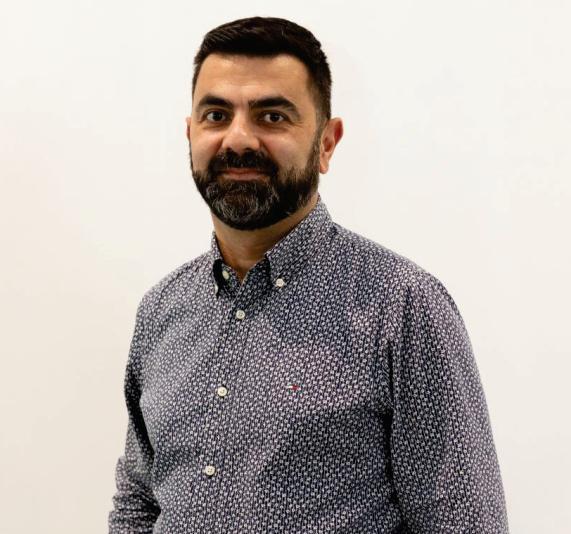
A/Prof StéphaneBouchouchaisanAssociateProfessorandAssociateHeadofSchool(International) in the School of Nursing and Midwifery at Deakin University, and the Australasian College for Infection Prevention and Control President-Elect. He is also a researcher based in Deakin’s Institute for Health Transformation and the Centre for Innovation in Infectious Disease and Immunology Research (CIIDIR).
With over 20 years’ experience as a clinician and an academic, Stéphane has worked in a variety of clinical (critical care, Infection Prevention and, Leadership and management) and community settings. Stéphane’s research programme has a focus on Infection Prevention and Control, andclinicians’behaviourstominimiseAMR.
Stephen Muhi, Rodney James, Karishma Priti Nandan, Callum McEwan, Angeline Ferdinand, KirstyBuisingonbehalfoftheCOMBAT-AMRprogram.
Aim:Todescribethedevelopment,implementationandevaluationofanAMSeducationalplatformforclinicalstaffwithin hospitalsacrosstheWesternPacificregion.
Methods:ThecontentoftheWesternPacificantimicrobialstewardship(WPAMS)educationalmoduleswereadaptedand revised from the World Health Organisation Western Pacific Region AMS training workshop [20 January 2020]. To categorise the WPAMS modules, they were divided into two overarching knowledge packages: (1) operational aspects of how to establish and evaluate an AMS program, and (2) case-based clinical scenarios. Early stakeholder engagement further refined the selected topics. The modules were designed to align with the concepts of adult learning theory (Knowles).Theywerenotdesignedtobepassivelearningtools;rather,theywereintendedtoserveasbaselineinformation to inform subsequent group-based discussion. These discussions were held online with a panel of interdisciplinary content specialists to expand on their chosen topic Experiences regarding areas of difficulty were shared. Presenters chose topics within their scope of regular practice, and each module was peer reviewed prior to recording. The modules were hosted on REDCap, alongside an implementation guideline, with recordings hosted unlisted on YouTube and availabletodownloadthroughaccesstoGoogleDrive.Voluntaryandanonymousevaluationquestionsincorporatingboth quantitative and qualitative measures were within each module of the REDCap program. In 2021, virtual and hybrid workshopswerepilotedinFiji,andevaluatedusingaseriesofroundtablediscussionsandinterviews.
Results: Sixteen modules were developed and implemented. In total, 90 users had accessed the online modules and completedatleast1module.Fulldemographicswerecompletedby66users.Themajority(74%)werefromFiji,withothers from Samoa (13%), Bhutan (8%), or Timor-Leste (3%). Most usersreported that their key learning objectives were met and had confidence incorporating knowledge into their role. The majority also agreed that they were engaged with the content, and it was appropriate for their level of understanding. During the Fiji evaluation phase, roundtable discussions andkeystakeholderinterviewswithusers(n=11)wereconductedacrossthreehospitals.Allstakeholdersreportedthatthe WPAMS modules had led to changes in their own professional practice or in identifiable changes on the wards. Module content was shown to be appropriate to the local context Suggestions for additional modules were made. Engagement withmodulesvariedandwasinfluencedbythepresenceoflocalchampions.Usersexpressedaninterestinemployinga localtrain-the-trainerapproachtodeploythemodulesmorebroadly
Conclusions:TheWPAMSeducationalplatformwaslargelysuccessfulasatoolfordeliveringAMSknowledgeacrossthe region.Thenextphasemustfocusondrivingsustainability,refiningcontentoflocalrelevance,andpromotingtheaccess acrosstheregion.
Funding: This work was funded by the Australian Government Department of Foreign Affairs and Trade's Indo-Pacific CentreforHealthSecurityfundedCOMBAT-AMRProgram.
Dr Rod James� is a Medical Microbiologist at the Melbourne Diagnostic Unit Public HealthLaboratory(MDUPHL)andtheDirectorofClinicalServicesattheRoyalMelbourne Hospital's Guidance Group and National Centre for Antimicrobial Stewardship (NCAS). Rod has been involved with antimicrobial resistance and antimicrobial stewardship research for the past 10 years, with a major interest in implementation of capacity building programs in regional and remote Australian facilities and in low- and middleincome countries within the Asia Pacific region. Rod is the current Antimicrobial ResistanceThemeco-leadattheDohertyInstitute.

Ethan R. Wyrsch, Dmitriy Li, Max L. Cummins, Barbara Drigo , Walter O. Okelo , Keith Hayes ,
RoyfordMagiri ,VincentLal ,NumaVera ,EricaDonner &StevenP.Djordjevic onbehalfofthe EMARFijiPartnership
1AustralianInstituteforMicrobiologyandInfection,UniversityofTechnologySydney,Ultimo,NSW,2007,Australia
2FutureIndustriesInstitute,UniSASTEM,UniversityofSouthAustralia,MawsonLakes,SA,5095,Australia
3The Commonwealth Scientific and Industrial Research Organization (CSRIO), Land and Water, Black Mountain, Canberra, ACT 2601, Australia
4DepartmentofVeterinaryScience,FijiNationalUniversity,Koronivia,Nausori,FijiIslands
6DepartmentofPharmacyandPharmacology,FijiNationalUniversity,Suva,FijiIslands
Introduction:Wholegenomesequencing(WGS)hasimprovedourunderstandingofbacterialphylogenetics beyondearlymolecularcharacterisationandbiochemicalperformancetolineagedifferentiation,uncovering new species and sub-species within most genera. Analysis of bacterial WGS allows the characterisation of potential pathogens, antimicrobial resistance, and identification of potential transfer pathways between sources.Transferbetweenclinical,agriculturalandenvironmentalnichesareofparticularimportance.
Methods:Bacterialisolates(n=379)werefromnumerousenvironmentalsampletypes,includingmanure,soil andwaterfromtheKoroniviaResearchStation(dairyfarm[n=55],piggery[n=88]andvegetablefarm[n=54]), biosolids from a municipal dump in Sigatoka (n=24), soil from the Colonial War Memorial Hospital (n=42), water and soil from My Suva Picnic Park (n=30), and both sediment and water samples from Laucala Beach (n=86). Most isolates were cultured under antibiotic selection, including carbapenem (n=124), cefotaxime (n=85), colistin (n=132), or ESBL (n=9) testing. Short-read whole genome sequences were generated using an IlluminaNextSeqplatformandassembledwithshovill.BioinformaticanalysiswasperformedusingPhyloSift, parsnpandotherpipelinestogeneratephylogenetictrees,ABRicatetoperformgenotyping,andspecificsubtypingpipelineslikeMLST.
Results: Species identification reported 25 separate genus, primarily Gammaproteobacteria. Two were particularlydominant,Enterobacterspp (n=123)andStenotrophomonasspp (n=134),withPseudomonasspp thirdatn=27 Thearrayofantibioticresistancegenes,virulencefactorsandmobilegeneticelementsidentified fromsuchavarieddatasetwaslarge(over600alleles),withevidenceofbothintrinsicandmobilisedantibiotic resistance present Initial phylogenetic analysis of the two primary genus highlighted many lineages shared betweendifferentsourcesandsampletypes.
Conclusion:ThisdatasetrepresentsoneofthefirstOneHealthsurveysofbacterialWGSinFiji,servingasafirst steptogeneratingadetailedunderstandingofthepresenceofpathogensandantimicrobialresistanceinthe Fijianenvironment.
Dr Ethan Wyrsch is a postdoctoral research associate at the Australian Institute for MicrobiologyandInfection(AIMI)attheUniversityofTechnology,Sydney.HehasaPh.D. inmolecularmicrobiologyandgenomicepidemiology,andhiscurrentresearchincludes characterisingbacterialpathogensandantimicrobialresistancethroughwholegenome sequence analysis. While the majority of Ethan's work has focused on agricultural and environmental Escherichia coli, he has experience with the characterisation of diverse bacterialgenusfromenvironmentalsources.

Aneley Getahun Strobel, Shammi Prasad , Matthew Richards , Ravi Naidu , Vinita Prasad , 4
PrinikaPrasad ,AshlynDatt ,DonnaCameron ,BenjaminHowden andKirstyBuising
1DepartmentofInfectiousDiseasesatthePeterDohertyInstituteforInfectionandImmunity,theUniversityofMelbourne,792Elizabeth Street,Melbourne,VIC3000,Australia
2Australianvolunteerinternational,PacificPeopleOffice,Level2,BSPCentralStreet,Suva,Fiji
3RoyalMelbourneHospital,300GrattanStreet,MelbourneVIC3052,Australia
4MinistryofHealthandMedicalServices,ColonialWarMemorialHospital,Waimanuroad,Suva,Fiji
5 Microbiological Diagnostic Unit, Public Health Laboratory, Peter Doherty Institute for infection and Immunity, 792 Elizabeth Street, Melbourne,VIC3000,Australia
Background and objectives: It is important that all health services are prepared to manage outbreaks of pathogenswithcriticalantimicrobialresistance(AMR). betterprepareColonial Theaimofthisprojectwasto WarMemorialHospital(CWMH),Fijitodetect,manageandrespondtoinfectionscausedbythesepathogens tohelpmitigatetheirimpact
Methods: A multifaceted approach was used to assess the existing situation and capacity at CWMH. This included a survey of staff, a desktop review of policies/procedures/guidelines, ward audit and observational walkthrough. A formal tabletop exercise was then conducted to further highlight gaps that needed to be addressed. The collated information was used to inform the development of standard operating procedures for the laboratory and clinical staff about screening strategies and management of colonised and infected patients. A series of formal and informal education sessions for clinical and laboratory staff were undertaken andaudittoolsweredevelopedandusedtomonitorcompliancewithprocedures.
Results: For the duration of the project, a total of 394 nurses/doctors and 42 laboratory staff attended 20 trainingsessions.Between12Januaryand31ofApril2023,82high-riskpatients,mainlyfromtheintensivecare unit,werescreened;13wereidentifiedascolonisedwithacarbapenem-resistantorganism(CRO).Monitoring of compliance with management procedures implemented showed high levels of adherence to CRO case isolation (100%) and notification of cases to clinical team (91%). Auditing of compliance with contact precautions demonstrated particular steps in donning and doffing personal protective equipment that neededfurthereducation.
Conclusion: This project has demonstrated the feasibility of establishing critical AMR surveillance and managementofCROsinamiddle-incomecountry Ongoingsupportisneededforitssustainability Highstaff turnoverandshortsupplyoflaboratoryconsumableswereamongthemajorchallenges.
Aneley is a research project manager on antimicrobial Resistance at the Peter Doherty Institute for Infection and Immunity in Melbourne. She is an accomplished public health physician with a career spanning 25 years in Africa, Asia and the Pacific

Aneley’s research interests are mainly in communicable diseases and antimicrobial resistance.Sheactivelyworkstoestablishcollaborativenetworks,fosteringpartnerships among organizations and experts in the realm of epidemiology and public health to improvepopulationhealth.
AneleyholdsaPhDformthePeterDohertyInstituteatUniversityofMelbourne,aMasters in clinical tropical medicine from the University of Mahidol in Thailand and a Medical DoctoratefromAddisAbabaUniversityinEthiopia.
Regional AMR Project Officer
Regional Representation for Asia and the Pacific, World Organisation for Animal Health
Abstract
TheWorldOrganisationforAnimalHealth(WOAH,foundedasOIE),since2016,hasbeencommitted tothedatacollectiononAntimicrobialAgentsintendedforUseinAnimals(AMU)fromitsMembers. It is also WOAH's responsibility to manage the accumulated data in a global database as well as to publish global AMU report annually According to the latest annual AMU report published in June 2023,157countriesand territoriesinthe worldsubmittedtheir responsetoWOAH'sdatacollection survey
TheRegionalRepresentationforAsiaandthePacific(RRAP)oftheWOAHhasbeensupportingthe Regional Members in building their capacities on AMU data collection at national level through physicalandvirtualtraining.OneofthekeyanduniqueactivitiesintheRegionistheNationalAMU Workshop, which were conducted in 13 countries before the COVID-19 pandemic Revitalizing the workshop series and supporting more Members with identifying the key stakeholders in AMU supplychainwillbenefitthecountrieswhoareaimingtoimproveitsdataquality,andtoultimately promotemoreresponsibleAMU.
The presentation will also introduce the WOAH's new online platform ANIMUSE, launched in September 2022, and its key features that are designed to encourage and reinforce the ownership andmanagementoftheAMUdatabyeachoftheMembersthemselves.
SPEAKERPROFILE: DrNahokoIeda
Nahoko IEDA is Antimicrobial Resistance (AMR) Regional Project Officer within Regional RepresentationforAsiaandthePacificinTokyo.HermissionistocontributetotheWOAH’sstrategy onAMRandresponsibleuseofantimicrobialsintendedforuseinanimals(AMU).SheistheWOAH responsible staff for the implementation of the various regional and national projects on AMR and AMUinAsiaandthePacific,aswellasforcoordinationwithQuadripartiteandotherpartners.
She holds PhD in Bioagricultural Sciences at Nagoya University, Japan (2015), specialized in mammalian reproduction, reproductive endocrinology and neuroendocrinology. Before joining the WOAH, she was the Livestock Development Officer at FAO Regional Office for Near East and North Africa (Cairo, Egypt; 2017-2019), followed by Animal Production Health Officer at FAO Representation in Syria (Damascus, Syria; 2019-2022). Previously, she worked as a researcher in the area livestock reproduction based in Japan with collaborators in South East AsiaandSouthAsiaforseveralyears.

Toatu Tebuka , Saketa Salanieta , Uluiviti Vasiti , Naivalu Taina , Babiau Raikabakaba Asaeli , Baleivanualala e a a f a Sakiusa ,BuadromoEka ,LeongMargaret ,ColeRussell ,VareaLalomilo
aPacific Community (SPC), Public Health Division, Narere, Suva, Fiji Islands.
bPacific Islands Health Officers Association (PIHOA), Hawaii, Honolulu, USA
cDepartment of Pathology and Medical Laboratory Science, Fiji National University, Suva, Fiji Islands.
dWorld Health Organization (WHO), South Pacific, Suva, Fiji Islands.
eOtago University, New Zealand.
fPacific Pathology Training Centre, Wellington, New Zealand.
Introduction: AMR surveillance and control is a challenge inmostPICTspartlyduetothefollowingreasonsweakAMR surveillance, lack of collaboration between microbiology and pharmacy in developing drug formulary on specific organisms, lack of antibiogram database, ineffective national Drug and Therapeutics Committee and weak Infection Prevention Control (IPC) both in hospital and communitysettings.
SPCanditspartners(FNU,PIHOA,PPTC&WHO)developed a training curriculum to assist Labs in the region in implementing quality Antimicrobial Susceptibility Testing (AST) that will contribute to the development of a quality antibiogramtoguideinformeddecisions.
Objective: The objective of this approach is to strengthen quality implementation of quality microbiology processes to produce an accurate and reliable antibiogram that will guideinformeddecisionsandactionstotackleAMRissues intheregion.
Method: From 2019 to 2022 a standardise training curriculum focusing on strengthening quality microbiology diagnostic procedures to produce quality ASTwasrolledouttofewselectedPacificcountries.In2023 a developed antibiogram database was rolled out to countries which participated in the training to produce an accurate and reliable antibiogram on the susceptibility of antibiotics used to treat infection The generated information on the antibiogram would be used to guide informeddecisionstoaddressAMR.

Results:
Conclusion:
Compilationandreportingofanantibiogramdatatoguide informed decision is a challenge in most laboratories in PICTs.Majorityofcountriesstillrelyheavilyonpaper-based system. The developed excel user-friendly antibiogram database has been rolled out to three (3) piloted site countries and already beneficial outcomes are noted in these countries. The trend in sensitivity pattern over time cannowbemadequicklyusingthesimplefunctionalityof thetool.

Mr Tebuka Toatu is from Kiribati and has been working with The Pacific Community (SPC) for the past twelve years. Prior to joining SPC, he had been a Director of Laboratory Services for over ten years at the Ministry of Health and Medical Services in Kiribati.

Mr Toatu is a Medical Laboratory Scientist by profession and holds a Bachelor of Applied Science in Medical Laboratory Science from RMIT University in Melbourne with majors in Advance Cytopathology and Haematology. In 2008, he completed his post graduate studies doing a Master of Science in Medicine from the University of Sydney
Currently, Mr Toatu is working with the Pacific Community at SPC Public Health Division as a Pacific Public Health Surveillance LabNet Coordinator providing laboratory strengthening activities in PICTs but focusing more on strengthening AMR surveillance and control through microbiology capacity training in the region.
Introduction: Antimicrobial resistance (AMR) is a global health threat, with third-generation cephalosporinresistant(3GCR)andcarbapenem-resistantinfectionsofparticularconcern.Thereis currentlyalackofgenomicdataonAMRorganismsinthePacificregion.Thisstudyaimstoaddress thisgapbyexaminingthegeneticdiversityofacollectionof450clinicalisolatescollectedbetween July2020-Feb2021fromSuva,Fiji.
Methods: Genomes were sequenced using Illumina and assembled with Unicycler Species and sequence types (ST) were determined using PathogenWatch; AMR genes were assigned using AMRFinderPlus. Nine isolates underwent additional long-read sequencing to determine the locationofcarbapenemasegenes.
Results: Of 450 sequenced isolates, 362 were Gram-negative and 88 were Gram-positive bacteria. For Gram-negative bacteria, there were 126 3GCR isolates and 107 carbapenem-resistant Acinetobacter and Pseudomonas. Klebsiella pneumoniae was highly diverse, with most STs represented by a single genome; there was less diversity in Escherichia coli, 42% of genomes belongedtoST131orST69 ThemediannumberofAMRgeneswaslowerinsensitivestrains(1-6vs917,genusdependent).FourteenESBLgenesweredetected;CTX-M-15wasthemostcommon(22%of genomes, all Enterobacterales). Eighteen carbapenemase genes were detected, primarily in Acinetobacter and Pseudomonas. OXA-23, OXA-66 and NDM-1 were the most prevalent, found in 10%, 18% and 17% of genomes respectively Phylogenetic analysis of two dominant clones (A baumannii ST2 and P aeruginosa ST773) revealed Fiji-specific clades comprising highly related strains.ForGram-positivebacteria,StaphylococcusaureusST1wasdominant;phylogeneticanalysis revealedasingleFijianclade,howeverstrainswererelativelydistinctfromoneanother
Conclusions: This study provides crucial genomic data on AMR organisms in Fiji, highlighting the diversity of 3GCR and carbapenem resistant species in the region. Local transmission of two carbapenem-resistantcloneswithinFijiwasobserved,underscoringtheimportanceoflocalspread oftheseresistantstrains.
SPEAKERPROFILE: DrJaneHawkey
Dr Jane Hawkey is a Research Fellow in the Department of Infectious DiseasesatMonashUniversity SheundertookherPhDattheUniversity of Melbourne, where she developed a novel genomic method for detecting bacterial transposases in whole genome sequencing data, to study how transposases have impacted the on-going evolution of Shigella species. Jane’s current research uses her genomics skills to study the evolution and spread of antimicrobial resistance in Gram negative bacterial pathogens, with a specific focus on developing new methodsfortrackingthetransmissionofplasmids.

1 Discipline of Agriculture and Food Technology, the University of the South Pacific, Samoa Campus
2 College of Agriculture, Fiji National University
The overuse of antibiotics in livestock farming has raised significant concerns due to the development of antibiotic resistance (AR) and its potential impact on human health. As a result, thereisagrowingneedtoexplorealternativestrategiestomaintainanimalhealthandproductivity whileminimizingtheuseofantibiotics.
Several compounds, which selectively stimulate the growth and/or activity of beneficial microorganisms in the gut, have emerged as promising alternatives to antibiotics in livestock production, especially in monogastric species. This review aims to provide a comprehensive overview of the use of selected antibiotic alternatives (prebiotics, probiotics, dietary fibre, and phytogenic compounds) as an alternative approach to antibiotics in livestock, focusing on their mechanisms of action, effects on gut microbiota composition, and their impact on animal health andperformance.
The review highlights the potential of several alternative compounds to antibiotics in maintaining animal health and addressing the concerns related to AR. There is , however, the need for further investigationsonthepracticalapplicationandcost-effectivenessinlargescalelivestockoperations.
Dr SiakaSeribaDiarraisanAssociateProfessorofAnimalScienceintheDisciplineofAgricultureand FoodTechnologyatUSPSamoaCampus.Academicqualifications:BachelorofAgriculture(Animal Husbandry) from Mali, MSc (Animal Production and Management), PGD (Education), and PhD (Monogastric Animal Nutrition) from Nigeria. Work experience: taught animalproductioncoursesindifferentinstitutionsinNigeriaandjoined USPinAugust2012 Ihavesuccessfullysupervisedandexaminedseveral Higher Degree (Master and PhD) theses in Animal Science from different institutions. I have published in excess of 100 publications in alternative feed resources and animal welfare in peer reviewed journals and presented at several international conferences Language experience:Bambara(nativelanguage),French,English,andHausa.

a b,** a,c d e Michael J. Loftus, Richard J. Everts, Allen C. Cheng, Perenise Eti, Timote Fakasiieiki, Lupeoletalelei d f a,g h d d a Isaia, Enita Isopo, Adam W. J. Jenney, Viali Lameko, Hinauri Leaupepe, Folototo Leavai, Sue J. Lee, e a f i i Mele Moungaevalu, Andrew J. Stewardson, Rosemary Tekoaua, Douglas Tou, Geoffrey Wuatai, and a,j,* Anton Y. Peleg
a Department of Infectious Diseases, The Alfred Hospital and Central Clinical School, Monash University, Melbourne, Australia
b Nelson Bays Primary Health, Nelson, New Zealand
c School of Public Health and Preventive Medicine, Monash University, Melbourne, Australia
d Tupua Tamasese Mea'ole Hospital, Apia, Samoa
e Vaiola Hospital, Nuku'alofa, Tonga
f Tungaru Central Hospital, Tarawa, Kiribati
g College of Medicine, Nursing and Health Sciences, Fiji National University, Suva, Fiji
h Oceania University of Medicine, Apia, Samoa
i Rarotonga Hospital, Rarotonga, Cook Islands
j Infection and Immunity Program, Monash Biomedicine Discovery Institute, Department of Microbiology, Monash University, Clayton, Australia
Abstract
Background
There are limited antimicrobial resistance (AMR) surveillance data from low- and middle-income countries, especially fromthePacificIslandsregion.AMRsurveillancedataisessentialtoinformstrategiesforAMRpathogencontrol.
Weperformedaretrospectiveanalysisofantimicrobialsusceptibilityresultsfromthenationalmicrobiologylaboratoriesof four Pacific Island countries – the Cook Islands, Kiribati, Samoa and Tonga – between 2017 and 2021. We focused on four bacteria that have been identified as 'Priority Pathogens' by the World Health Organization: Staphylococcus aureus, Escherichiacoli,KlebsiellapneumoniaeandPseudomonasaeruginosa.
Findings
Followingdeduplication,atotalof20,902bacterialisolateswasincludedintheanalysis.Themostcommonorganismwas E coli(n=8455)followedbyS aureus(n=7830),K.pneumoniae(n=2689)andP aeruginosa(n=1928).Theprevalenceof methicillinresistanceamongS.aureusisolatesvariedbetweencountries,rangingfrom8%to26%intheCookIslandsand Kiribati,to43%inbothSamoaandTonga.CeftriaxonesusceptibilityremainedhightomoderateamongE.coli(87%–94%) and K. pneumoniae (72%–90%), whereas amoxicillin + clavulanate susceptibility was low against these two organisms (50%–54%and43%–61%,respectively).Highsusceptibilitywasobservedforallanti-pseudomonalagents
Methods (83%–99%).
Despitechallenges,thesePacificIslandlaboratorieswereabletoconductAMRsurveillance.Thesedataprovidevaluable contemporary estimates of AMR prevalence, which will inform local antibiotic formularies, treatment guidelines, and nationalprioritiesforAMRpolicy
Funding
SupportedbytheNationalHealthandMedicalResearchCouncil.
SPEAKER: Dr Michael Loftus
Dr Michael Loftus is an Infectious Diseases Physician and researcher from Monash University,Australia.From2019-2022hecompletedhisPhDonantimicrobialresistance in the Pacific Islands, with a particular focus on Fiji. His other research interests include theintersectionsbetweenclimatechangeandhealth.

2 World Organisation for Animal Health
Mycobacterium bovis causes tuberculosis in cattle and when transmitted to humans typically causes extra-pulmonary tuberculosis (EPTB). Bovine tuberculosis (bTB) has a global distribution and is controlled in most countries to protect animalandpublichealth.
CattlefarminghaslongbeentraditionallyconsideredasapromisinglivestocklivelihoodinFiji.Thus,thecontrolofbovine tuberculosis(bTB)ishighlyconsideredapriorityforanimalhealth,biosecurity,andhumanhealthauthoritiesinthissmall islandasevidentfromthelong-termfundingoftheBovineBrucellosisandTuberculosisEradicationandControlprogram (BTEC). The surveillance program made notable improvements since it commenced in the 1980's, sustained by government funding and industry cooperation. Two retrospective studies utilizing data of the Fiji BTEC program from 1999to2020wasundertakenthrutheUniversityofSydneywithsupportfromtheFijiGovernment AllavailablebTBdatafor cattlewereanalyzedtoevaluatetheperformanceoftheFijiBTECprogramfrom1999to2014andagainfrom2015to2020 A pilot investigation was conducted to look for putative zoonotic TB (extra pulmonary tuberculosis) in people, complimentary to the Fiji BTEC program cases. The study aimed to evaluate practices that might contribute to persistenceandtransmissionofM.bovisbetweencattleandtohumans.ExistingdatasetsweresharedbetweenMinistry ofAgricultureandMinistryofHealthFiji.
This case study highlights the lessons learned for bTB control in Fiji, the One Health consequences associated with the persistenceofbTBinfectionincattleherdsinFiji,theimportanceoftechnicalandsocialconsiderationstoachievesuccess indiseasecontrol;theimpactofcontributionfromregionalpartnersintheprocess.
Control of bTB in Fiji is a long-term objective that must have multiple stakeholder engagement and regular review to measuresuccess.FurtherstrengtheningoftheprogramtargetingthemaincontributorstobTBpersistence,maintenance ofacomprehensivereportingandtraceabilitysystem,industryawarenessandsupportarekeyactions.
CorrelationofbovinetuberculosisandEPTBcasesinhumans,particularlyinthecattlefarmingcommunitiesinFiji,needs to be fully established thru follow up study including an assessment of lifetime EPTB diagnoses, classification of farms basedonmorerecentbTBtestdataandmoleculartypingofM.bovisisolatesfromhumans,cattleandtheenvironment A targetedawarenessandeducationapproachisrequiredtoreducethefutureriskofzoonoticTBandtohelpensureuptake ofrecommendationsandpracticesaimedatcontrollingandpreventingbTB.
Keywords: bovine tuberculosis, zoonotic TB, One Health, disease control, surveillance, BTEC, Fiji,
DrElvaBorja,isaveterinarianwithaMastersdegreeinVeterinaryPublicHealthManagement SheiscurrentlyaSupportConsultantof theWorldOrganisationforAnimalHealthoftheRegionalRepresentationforAsia-PacificbasedinTokyo Herroleisfocusedonsupporting WOAH regional activities on national veterinary workforce development and transboundary animal diseases, particularly in the Pacific Islandcountries.
Her 16-years work experience in the Pacific gave her the opportunity to take on various roles and be connected with different agencies in the veterinary domain, including as an Animal Health Laboratory Scientist and Animal Health Training Officer for the SPC LRD Animal Health and Production, Senior Veterinary Officer at the Fiji Veterinary Laboratory, OIC for Animal Health with the Ministry of Agriculture, as consultant with GIZ on climate change livestock adaptation and with World Animal Protection for livestock emergency management She also established a private veterinary clinical practice to cater for pet animals along the SuvaNavua corridor. Dr Borja also had academic teaching experience conducting trainings on animal health, veterinary epidemiology, veterinary microbiology, laboratory diagnostics, Paraveterinary training, livestock emergency management and animal welfare. Her research publications is focused on zoonotic bovine tuberculosis, documenting the progress of the bovine tuberculosis control program and its impact on the communities of Fiji.
As a veterinarian in the Pacific, her main goal is to foster a community with a healthy population of animals and humans harmoniously living together in a rich natural environment with a selfsustaining livestock livelihood.

Antimicrobial resistance (AMR) is a complex challenge of global significance that decision makers are addressing at multiple scales – local, national and international. Addressing AMR effectively requires governance interventions tailored to local and national contexts connected to global initiatives,buildingsharedunderstanding,networksandcapacity
The Enhancing the Management of Antimicrobial Resistance (EMAR) project explored the governance of AMR and antimicrobial use (AMU) in Fiji, taking a One Health perspective. My presentation will share how this work built on previous One Health and Pacific climate adaptation governanceresearch,thetoolsandapproachesused,andprojectoutcomes.
SPEAKERPROFILE: DrSeonaMeharg

Dr Seona Meharg is an interdisciplinary social scientist researching how individuals and organisationslearnandchange,specificallyaskingwhatenablesindividualsandgroupstotakeup ownership of knowledge, tools, and processes for more informed decision-making in complex domains such as climate adaptation, disasterriskreductionandhealth.
Seona’s research addresses the vital challenge of implementation, asking why even with the necessary information, people do not act. In addition,herresearchmeasurestheimpactofhowchangesinbehaviour andknowledgeleadtoimproveddecisionsandactions.
INFECTIONS:APROSPECTIVECOHORTSTUDYINSUVA,FIJI
b,1 a b
a,1
MichaelJ.Loftus ,TraceyE.M.W.Young-Sharma ,SueJ.Lee ,ShitanjniWati ,
GneiZ.Badoordeen , LukeV.Blakeway , SallyM.H.Byers , AllenC.Cheng ,
Ben S. Cooper , Hugh Cottingham , Adam W.J. Jenney Jane Hawkey , Nenad Macesic
b b b b b a
RaviNaidu , AmiteshPrasad , VinitaPrasad , LitiaTudravu , TimociVakatawa , ElkevanGorp , Jessica
a h a , i , 2 a ,2
A. Wisniewski , Eric Rafai , Anton Y. Peleg , **, Andrew J. Stewardson , *
a Department of Infectious Diseases, The Alfred Hospital and Central Clinical School, Monash University, Melbourne, b Australia Colonial War Memorial Hospital, Suva, Fiji
c d School of Public Health and Preventive Medicine, Monash University, Melbourne, Australia Centre for Tropical e Medicine and Global Health, Nuffield Department of Medicine, University of Oxford, Oxford, United Kingdom Mahidolf Oxford Tropical Medicine Research Unit, Mahidol University, Bangkok, Thailand Fiji National University, Suva, Fiji
Infection and Immunity Program, Monash Biomedicine Discovery Institute, Department of Microbiology, Monash University, Clayton, Australia
Objectives: There are scant primary clinical data on antimicrobial resistance (AMR) burden from low- and middle-income countries (LMICs). We adapted recent World Health Organization methodology to measure theeffectofthird-generationcephalosporinresistance(3GC-R)onmortalityandexcesslengthofhospitalstay inFiji.
Methods: We conducted a prospective cohort study of inpatients with Enterobacterales bloodstream infections (BSIs) at Colonial War Memorial Hospital, Suva. We used cause-specific Cox proportional haz- ards modelstoestimatetheeffectof3GC-Ronthedailyrisk(hazard)ofin-hospitalmortalityandbeingdischarged alive(competingrisks),andweusedmultistatemodellingtoestimatetheexcesslengthofhospitalstay.
Results: From July 2020 to February 2021 we identified 162 consecutive Enterobacterales BSIs; 3GC-R was presentin66(407%).Crudemortalityforpatientswith3GC-susceptibleand3GC-RBSIswas167%(16/96)and 303% (20/66), respectively 3GC-R was not associated with the in-hospital mortality hazard rate (adjusted hazard ratio [aHR] 1.13, 95% confidence interval [CI] 0.51–2.53) or being discharged alive (aHR 0.99, 95% CI 065–1.50), whereas Charlson comorbidity index score (aHR 1.62, 95% CI 1.36–1.93) and Pitt bacteraemia score (aHR 3.57, 95% CI 1.31–971) were both associated with an increased hazard rate of in-hospital mortality 3GC-R wasassociatedwithanincreasedlengthofstayof2.6days(95%CI2.5–2.8).3GC-Rwasmorecommonamong hospital-associatedinfections,butgenomicsdidnotidentifyclonaltransmission.
Conclusion: Patients with Enterobacterales BSIs in Fiji had high mortality There were high rates of 3GC-R, whichwasassociatedwithincreasedhospitallengthofstaybutnotwithin-hospitalmortality
Dr Michael Loftus is an Infectious Diseases Physician and researcher from Monash University, Australia. From 2019 - 2022 he completed his PhD on antimicrobial resistance in the Pacific Islands, with a particular focus on Fiji. His other research interests include the intersections betweenclimatechangeandhealth.

1Colonial War Memorial Hospital, Suva, Fiji,
2Microbiological Diagnostic Unit Public Health Laboratory, The University of Melbourne at the Peter Doherty Institute for Infection & Immunity,
3Victorian Infectious Diseases Service, Royal Melbourne Hospital, Melbourne, Australia,
4Department of Infectious Diseases, The University of Melbourne, Melbourne, Australia,
5Department of Microbiology & Immunology, The University of Melbourne at The Doherty Institute for Infection and Immunity, Melbourne, Australia,
6Department of Infectious Diseases, Austin Health, Melbourne, Australia.
*COMBAT-AMR broader team members include Adam Jenney, Rodney James, Chantel Lin, Donna Cameron, Mathilda Wilmot and Karishma Nandan
Introduction: Carbapenem-resistant organisms (CROs) cause infections in hospitalised patients and are associated with limited options for treatment, and elevated rates of morbidity and mortality Long-term colonization leads to complex outbreaks, with transmission frequently detected in hospital settings due to staff movement and shared equipment Recognition of increased CRO isolated at CWM hospital prompted detailedcaseinvestigationandenhancedmicrobiologicaltesting.
Methods: All isolates underwent routine antimicrobial susceptibility testing (AST) at CWM laboratory with those displaying first-line resistances undergoing meropenem susceptibility disc test (subject to availability). Where CROs were confirmed, epidemiological surveillance data was collected to investigate similar isolates detected in patients with geographical or temporal links. One hundred and ninety-seven isolates were referred to Doherty Institue for enhanced AST and whole genome sequencing (WGS).
Results: Between June 2022 and March 2023, 196 patients at CWM Hospital had isolates of CRO confirmed, reaching a peak of 40 cases detected in January 2023. CROs were almost exclusively Acinetobacter baumannii, Escherichia coli and Pseudomonas aeruginosa, and many were from patients with clinical infections. Epidemiologic investigation revealed a concentration of patients with admissions to ICU, burns ward, acute medical ward and acute surgical ward; with disproportionate clustering of different gramnegative species in these wards. WGS of isolates indicated a dominance (487%) of NDM-7 E. coli (n=50) and NDM-1/OXA-23 A. baumannii (n=46).
Discussion: Support to ensure laboratories are capable of extended antimicrobial resistance (AMR) testing and hospital staff can collect epidemiologic information will facilitate the accurate detection and investigation of suspected hospital outbreaks of resistant pathogens. Targeted policies aimed at infection prevention control measures for CRO case management, alongside ensuring availability of a suite of appropriate antimicrobials for treatment, are needed. Outbreak characterization and the investigation of putative transmission clusters may benefit from the use of WGS, with extended AST to inform empiric treatment guidelines.
SPEAKER: DrTraceyYoung-Sharma
Tracey Young Sharma is a Consultant General Medicine Physician at ColonialWarMemorialHospital(CWMH),Fiji.Herinterestisininfectious diseases, microbiology and research in antimicrobial resistance. She is currentlytheInfectionPreventionControlCommitteeChairandinvolved in antimicrobialstewardshipactivitiesinCWMH.

